Winter in Virginia brings an array of beautiful and hardy bird species that endure the cold weather, making the state a haven for bird enthusiasts and nature lovers.
From feathery residents that remain throughout the year to migratory visitors seeking refuge from northern climates, the winter bird population in Virginia offers a delightful spectacle of colors, songs, and behaviors.
Whether you are an avid birder or simply enjoy the tranquility that birdwatching provides, Virginia’s winter birds provide ample opportunities for exploration and admiration.
In this essay, we will delve into the diverse and fascinating world of winter birds in Virginia and explore their adaptations, behaviors, and the best locations to spot these marvelous creatures during the chilly season.
51 Winter Birds In Virginia
Winter in Virginia welcomes a variety of bird species, adapting to the colder climate or migrating from higher latitudes. Here’s a list of 51 winter birds you might encounter in Virginia:
1. Dark-Eyed Junco (Junco hyemalis)
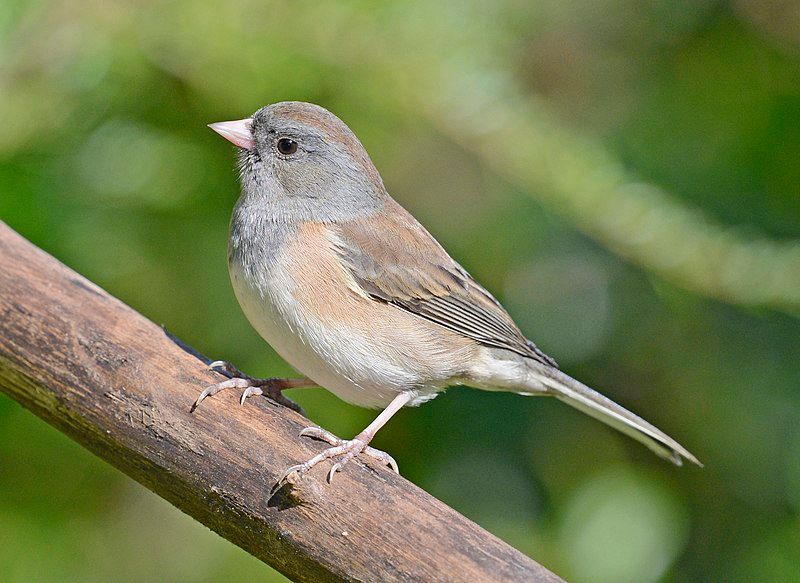
The Dark-Eyed Junco is a small, charismatic bird commonly found across North America. Known for their striking dark eyes and contrasting plumages, these birds exhibit regional color variations.
Typically, they have a slate-gray back and head with a white belly, making them easily recognizable. They prefer wooded areas and are often seen hopping on the ground, foraging for seeds. Juncos are social birds, often seen in flocks, especially during winter.
| Kingdom | Animalia |
| Phylum | Chordata |
| Clade | Dinosauria |
| Class | Aves |
| Order | Passeriformes |
| Family | Passerellidae |
| Genus | Junco |
| Species | J. hyemalis |
2. Downy Woodpecker (Dryobates pubescens)
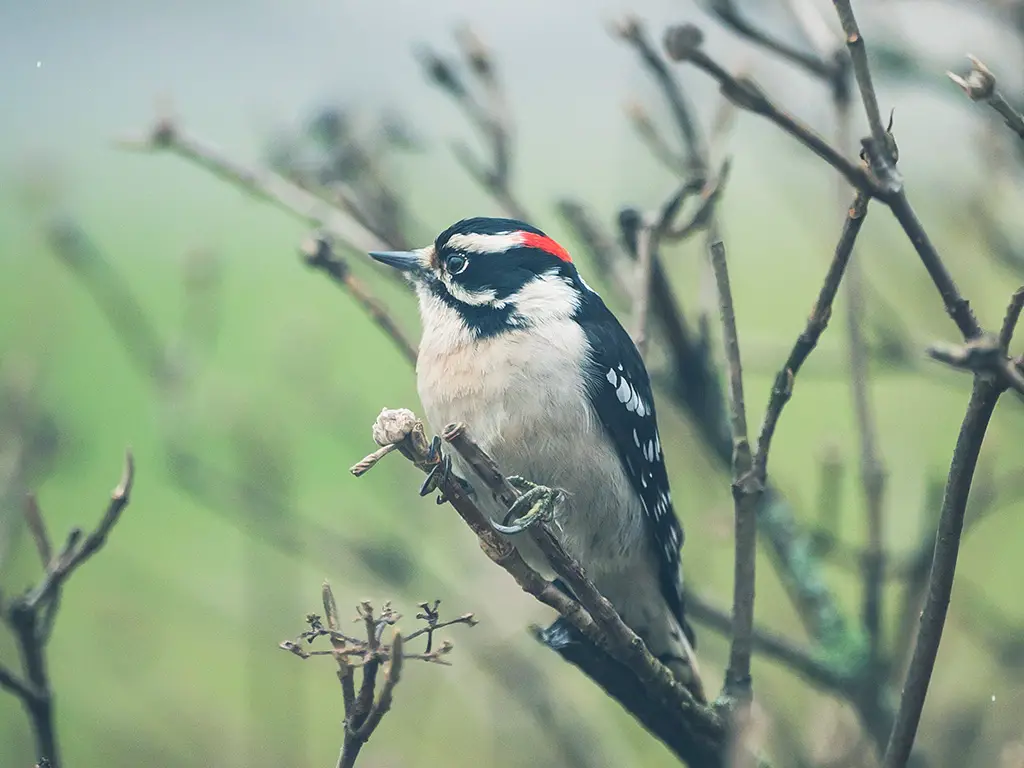
The Downy Woodpecker is the smallest in North America. It has a striking black and white plumage, with a white back, black wings spotted with white, and a distinctive white stripe down the back of its head.
Males have a small red patch on the back of their heads. These birds are agile and can be seen flitting around tree trunks and branches in search of insects. They are a common sight in woodlands, orchards, and backyards.
| Kingdom | Animalia |
| Phylum | Chordata |
| Clade | Dinosauria |
| Class | Aves |
| Order | Piciformes |
| Family | Picidae |
| Genus | Dryobates |
| Species | D. pubescens |
3. House Finch (Haemorhous mexicanus)
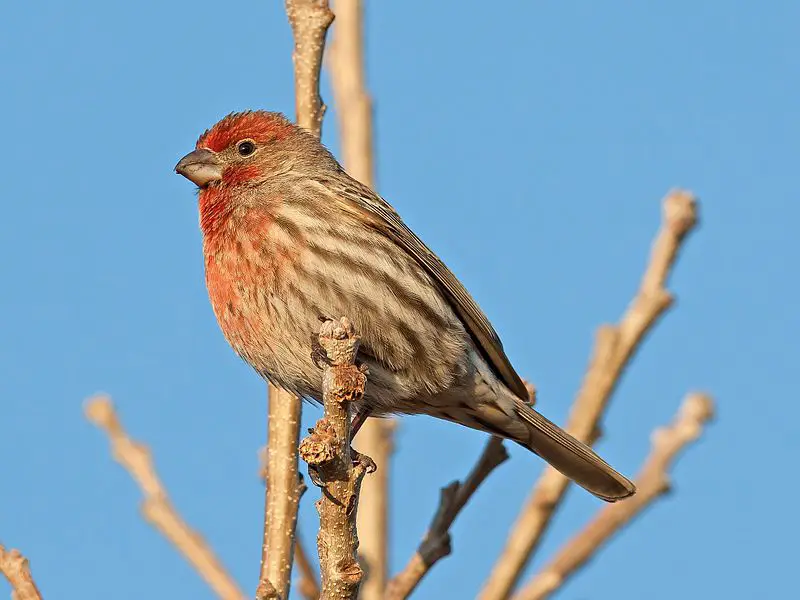
The House Finch is a small bird, common across the United States. Males are particularly striking with their bright red heads and breasts, while females are generally brown and striped.
These birds are highly adaptable and often found in urban and suburban areas. They are known for their cheerful, warbling song and are often seen in large, noisy flocks at feeders or perching on branches.
| Kingdom | Animalia |
| Phylum | Chordata |
| Clade | Dinosauria |
| Class | Aves |
| Order | Passeriformes |
| Family | Fringillidae |
| Genus | Haemorhous |
| Species | H. mexicanus |
4. White-Throated Sparrow (Zonotrichia albicollis)
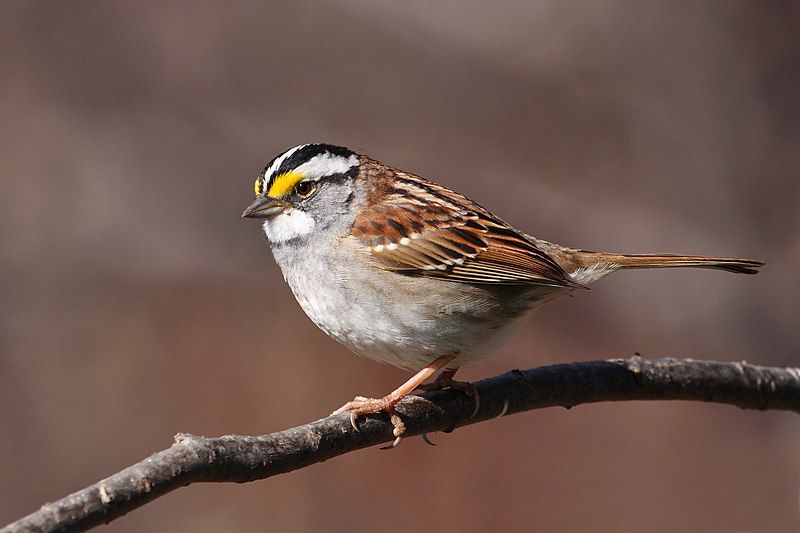
The White-Throated Sparrow is easily recognized by its distinctive white throat and yellow spots between the eyes and bill. It has a gray face, brown-streaked upper parts, and a white or tan-striped crown.
These birds are found in wooded areas, often on the ground or in low bushes. They have a beautiful, whistling song, which sounds like “Oh-sweet-canada-canada-canada.” They are migratory birds, breeding in Canada and wintering in the southern United States.
| Kingdom | Animalia |
| Phylum | Chordata |
| Clade | Dinosauria |
| Class | Aves |
| Order | Passeriformes |
| Family | Passerellidae |
| Genus | Zonotrichia |
| Species | Z. albicollis |
5. Red-Bellied Woodpecker (Melanerpes carolinus)
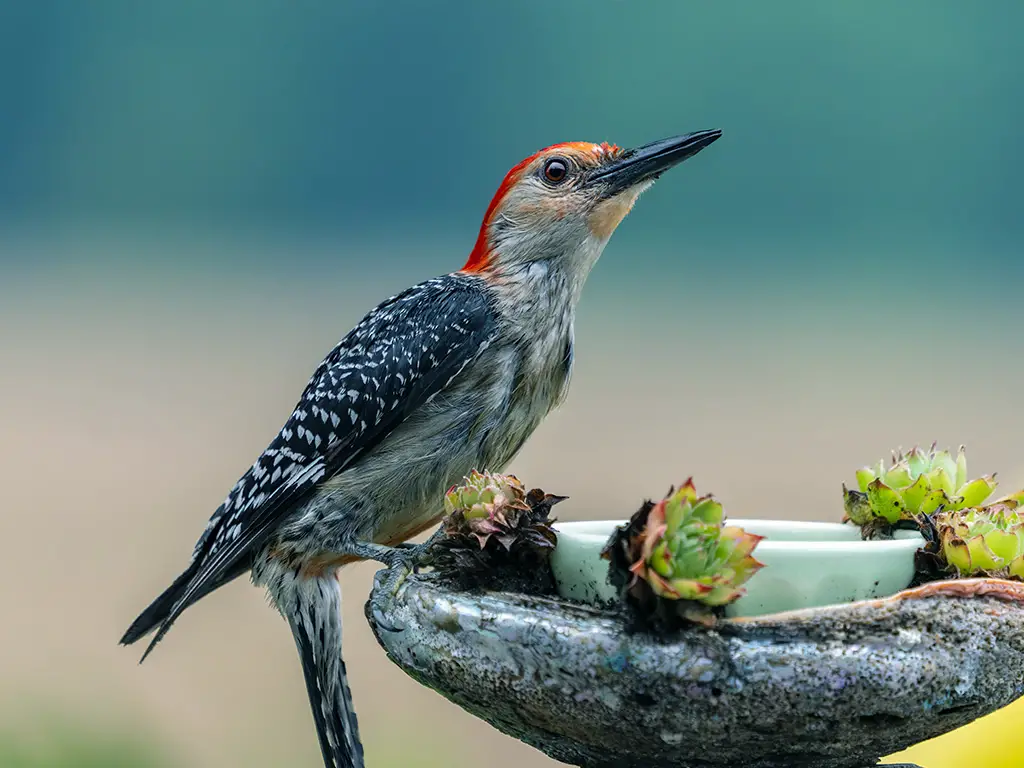
Despite its name, the Red-Bellied Woodpecker’s most distinctive feature is the red cap and nape, with males also having red on their throats.
The belly is subtly tinged with red. This medium-sized woodpecker has a black and white barred back and wings.
Common in eastern woodlands and forests, they are known for their loud call and drumming on trees. They feed on insects, fruits, and nuts, and are often seen at bird feeders.
| Kingdom | Animalia |
| Phylum | Chordata |
| Clade | Dinosauria |
| Class | Aves |
| Order | Piciformes |
| Family | Picidae |
| Genus | Melanerpes |
| Species | M. carolinus |
6. American Goldfinch (Spinus tristis)
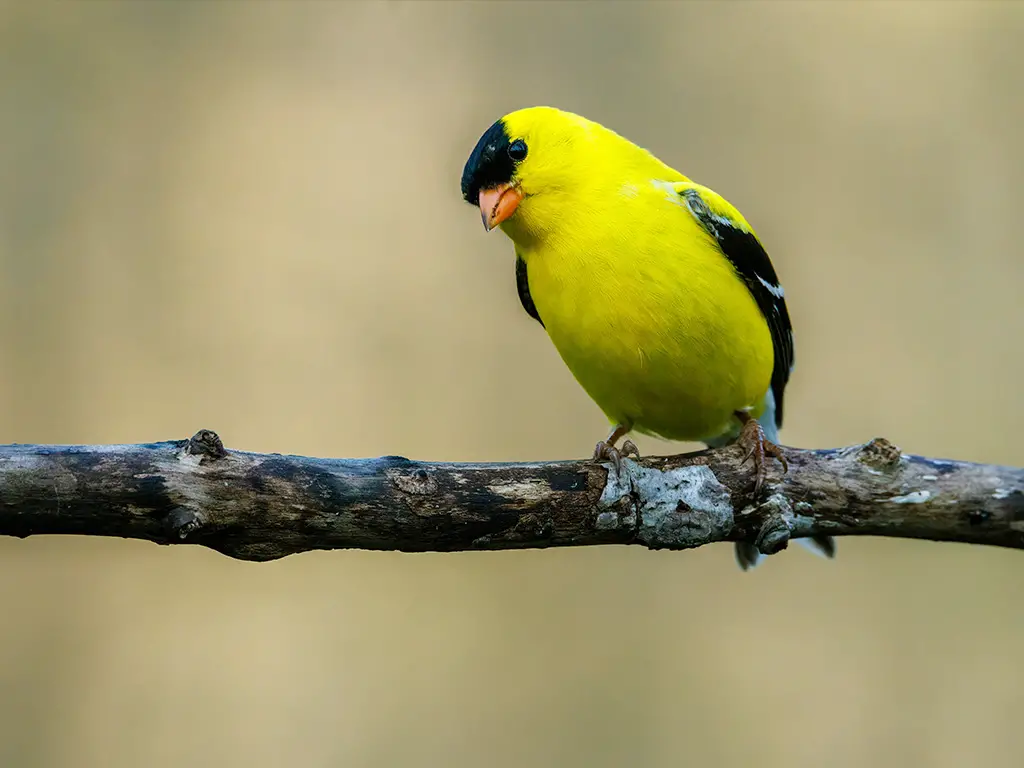
The American Goldfinch, distinguished by its vibrant yellow plumage in males during the breeding season, is a delight to birdwatchers. Females and non-breeding males are more subdued, with olive or brownish coloring.
They are small, with a conical bill and a notched tail. These birds are commonly found in open fields and gardens across North America, often visiting bird feeders. They primarily feed on seeds, especially from thistles and sunflowers.
American Goldfinches are known for their undulating flight pattern and cheerful, twittering song. They are social birds, often seen in flocks, particularly during migration.
| Kingdom | Animalia |
| Phylum | Chordata |
| Clade | Dinosauria |
| Class | Aves |
| Order | Passeriformes |
| Family | Fringillidae |
| Genus | Spinus |
| Species | S. tristis |
7. Northern Cardinal (Cardinalis cardinalis)
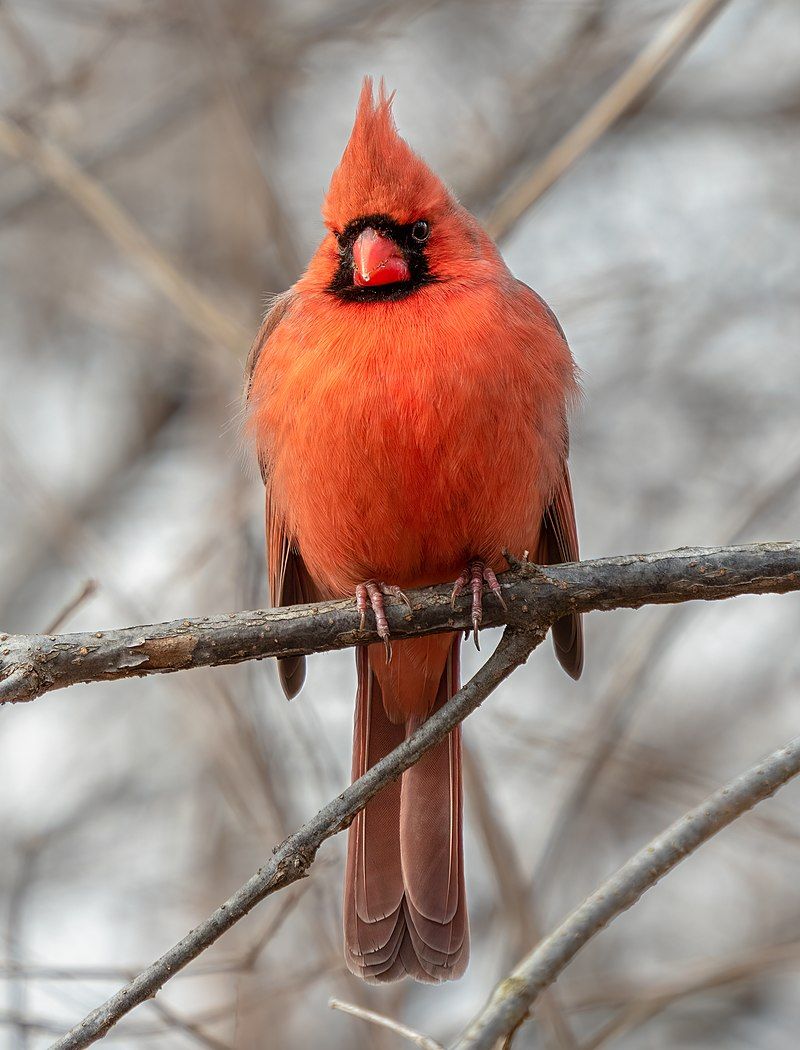
The Northern Cardinal is a beloved and easily recognizable bird, thanks to the male’s brilliant red plumage and the female’s warm, reddish-brown tones. Both genders have a distinctive crest on their heads and a black mask on the face, which is more pronounced in males.
These medium-sized songbirds are found in woodlands, gardens, and shrublands across eastern and central North America.
Cardinals are known for their clear, melodious songs and variety of calls. They are non-migratory and often bring color and vitality to backyard feeders, particularly in winter. Cardinals feed on seeds, fruits, and insects.
| Kingdom | Animalia |
| Phylum | Chordata |
| Clade | Dinosauria |
| Class | Aves |
| Order | Passeriformes |
| Family | Cardinalidae |
| Genus | Cardinalis |
| Species | C. cardinalis |
8. Blue Jay (Cyanocitta cristata)
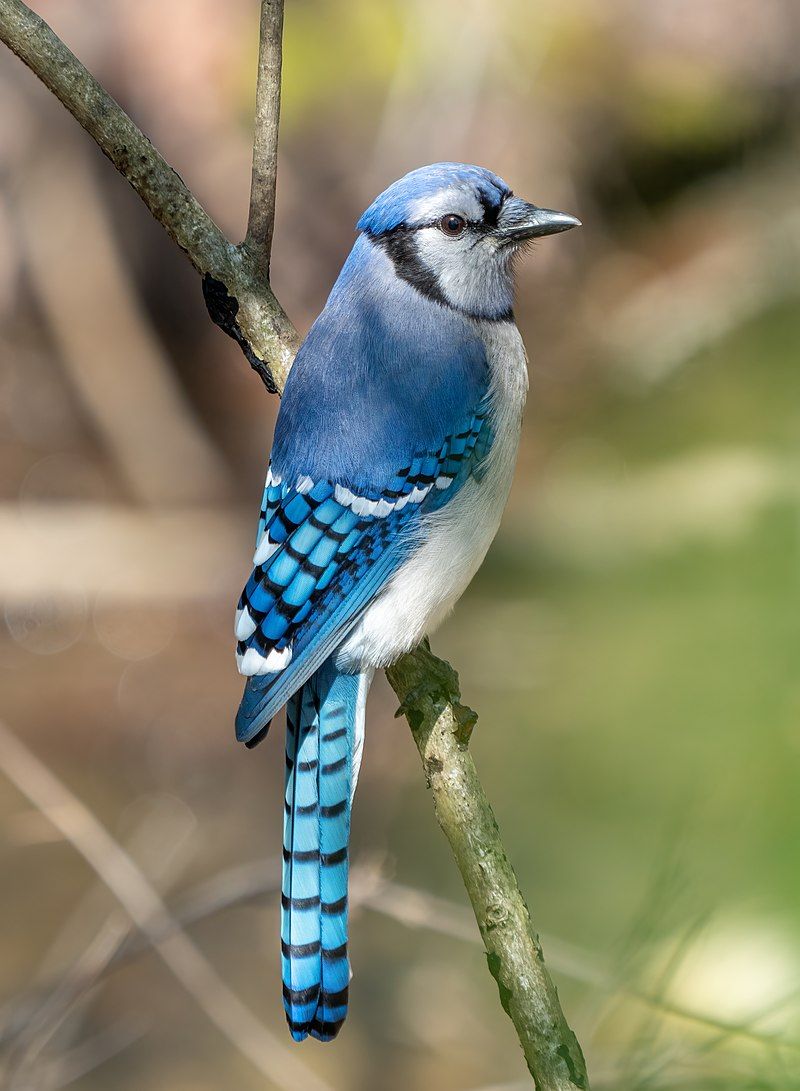
The Blue Jay is a striking bird with a mix of blue, white, and black plumage and a distinctive crest on its head.
These intelligent birds are known for their complex social systems and vast array of vocalizations, including excellent mimicking of other birds and even mechanical noises.
Blue Jays are common in forests, parks, and residential areas across eastern and central North America.
They are omnivores, feeding on nuts, seeds, insects, and occasionally small vertebrates. Blue Jays are also known for their role in seed dispersal, particularly of oak trees.
| Kingdom | Animalia |
| Phylum | Chordata |
| Clade | Dinosauria |
| Class | Aves |
| Order | Passeriformes |
| Family | Corvidae |
| Genus | Cyanocitta |
| Species | C. cristata |
9. Tufted Titmouse (Baeolophus bicolor)
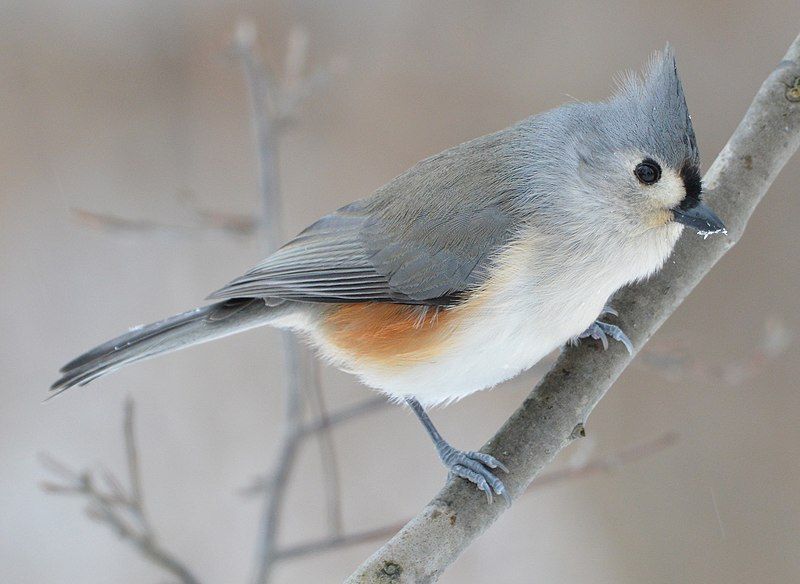
The Tufted Titmouse is a small, gray bird with a white breast and a prominent tuft on its head. It has large, round eyes and a stout bill. These birds are lively and vocal, known for their cheerful “peter-peter-peter” call.
They are common in woodlands, gardens, and at bird feeders in the eastern United States. Tufted Titmice are curious and bold for their size, often joining mixed-species foraging flocks.
Their diet consists primarily of insects and seeds. In winter, they are known to hoard food.
| Kingdom | Animalia |
| Phylum | Chordata |
| Clade | Dinosauria |
| Class | Aves |
| Order | Passeriformes |
| Family | Paridae |
| Genus | Baeolophus |
| Species | B. bicolor |
10. Mourning Dove (Zenaida macroura)
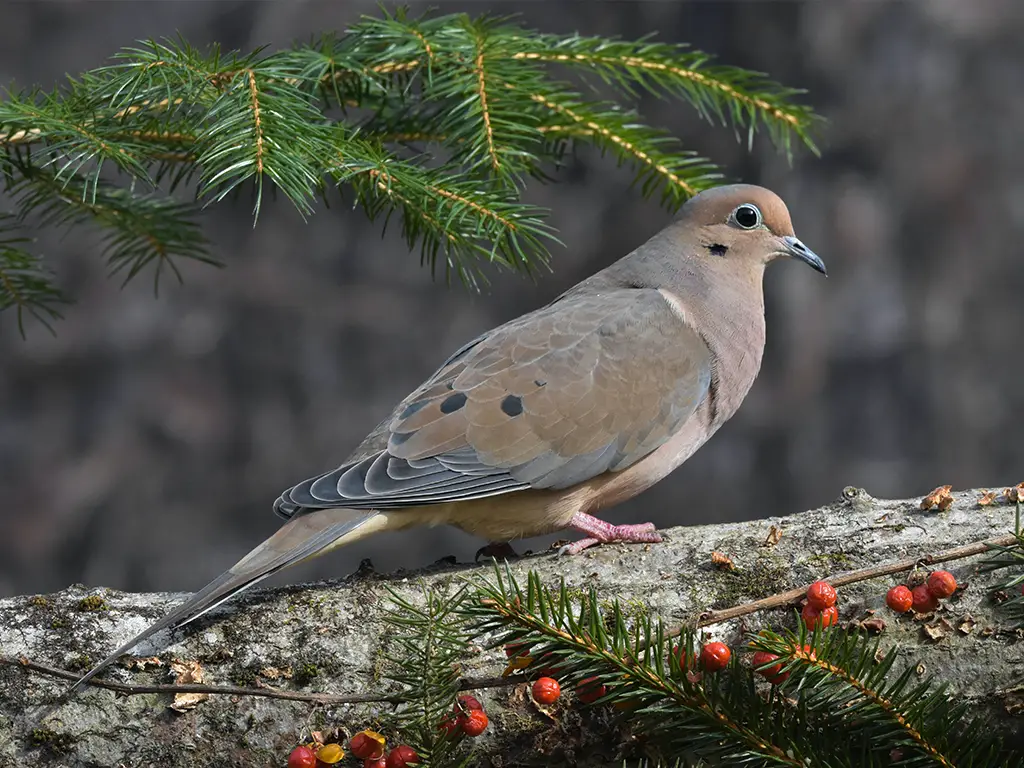
The Mourning Dove is a slender, graceful bird with a soft, grayish-brown body, black spots on the wings, and a long, pointed tail.
They are named for their mournful cooing call, which is a familiar sound in many habitats across North America, including open fields, woodlands, and urban areas.
These birds are often seen perched on telephone wires or foraging for seeds on the ground. Mourning Doves are strong fliers and can reach speeds of up to 55 mph. They form strong pair bonds and are often seen in pairs.
| Kingdom | Animalia |
| Phylum | Chordata |
| Clade | Dinosauria |
| Class | Aves |
| Order | Columbiformes |
| Family | Columbidae |
| Genus | Zenaida |
| Species | Z. macroura |
11. Carolina Chickadee (Poecile carolinensis)
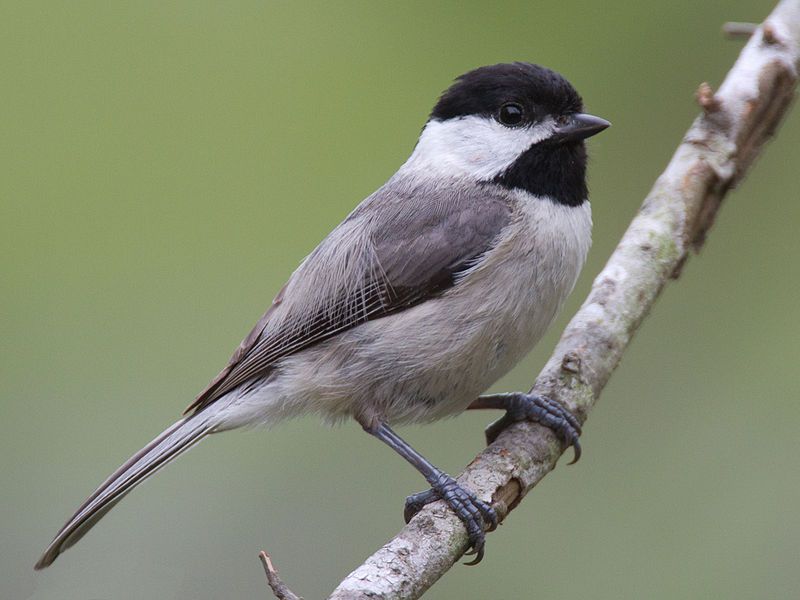
The Carolina Chickadee is a small, charming bird with a distinctive black cap and bib, white cheeks, and soft grayish-white underparts. Its upper parts are gray, and it has a short tail.
These birds are known for their cheerful and complex vocalizations, including their distinctive “chick-a-dee-dee-dee” call, which can vary in intensity depending on the threat level.
Carolina Chickadees are curious and acrobatic feeders, often seen hanging upside down on branches. They are residents of wooded areas, especially deciduous forests, in the southeastern United States.
Their diet consists mainly of insects, seeds, and berries. These birds are sociable, often seen in small groups or with mixed-species flocks.
| Kingdom | Animalia |
| Phylum | Chordata |
| Clade | Dinosauria |
| Class | Aves |
| Order | Passeriformes |
| Family | Paridae |
| Genus | Poecile |
| Species | P. carolinensis |
12. White-Breasted Nuthatch (Sitta carolinensis)
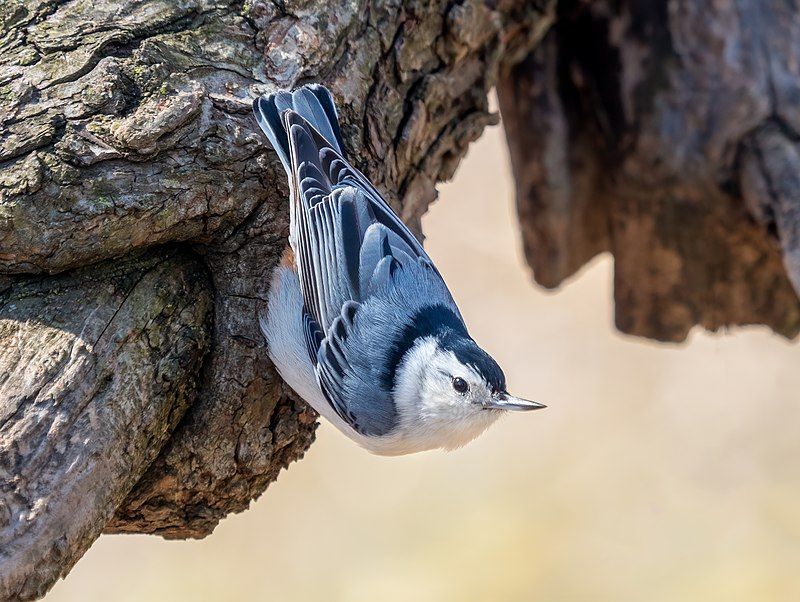
The White-Breasted Nuthatch is a small, sturdy bird with a large head, short tail, and a strong bill. It has a striking appearance with a white face and breast, blue-gray upperparts, and a black cap and nape.
One of its unique behaviors is its ability to walk down tree trunks headfirst, a feat not common among birds. They are found in forests, woodlands, and parks across much of the United States and southern Canada.
Their diet is varied, including insects, seeds, and nuts. White-Breasted Nuthatches are known for their nasal calls and are often seen caching food in tree bark.
| Kingdom | Animalia |
| Phylum | Chordata |
| Clade | Dinosauria |
| Class | Aves |
| Order | Passeriformes |
| Family | Sittidae |
| Genus | Sitta |
| Species | S. carolinensis |
13. Song Sparrow (Melospiza melodia)
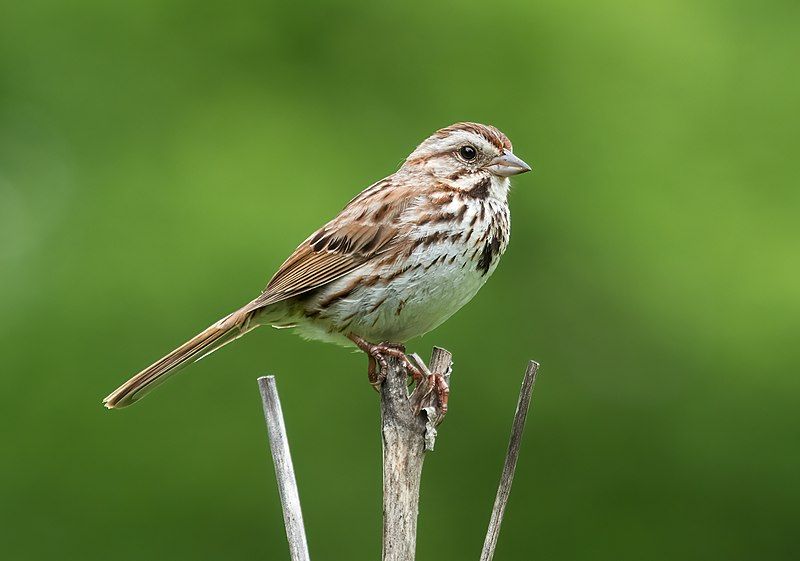
The Song Sparrow is a medium-sized sparrow known for its rich, melodious song, which varies regionally. It has a streaked brown appearance, with a distinctive spot in the middle of its breast.
These birds are adaptable and found in a wide range of habitats, including marshes, fields, and gardens across North America.
They forage on the ground for insects and seeds. Song Sparrows are known for their stout, rounded bills and relatively long, rounded tails.
They are approachable and often spotted near human habitation, singing from exposed perches.
| Kingdom | Animalia |
| Phylum | Chordata |
| Clade | Dinosauria |
| Class | Aves |
| Order | Passeriformes |
| Family | Passerellidae |
| Genus | Melospiza |
| Species | M. melodia |
14. House Sparrow (Passer domesticus)
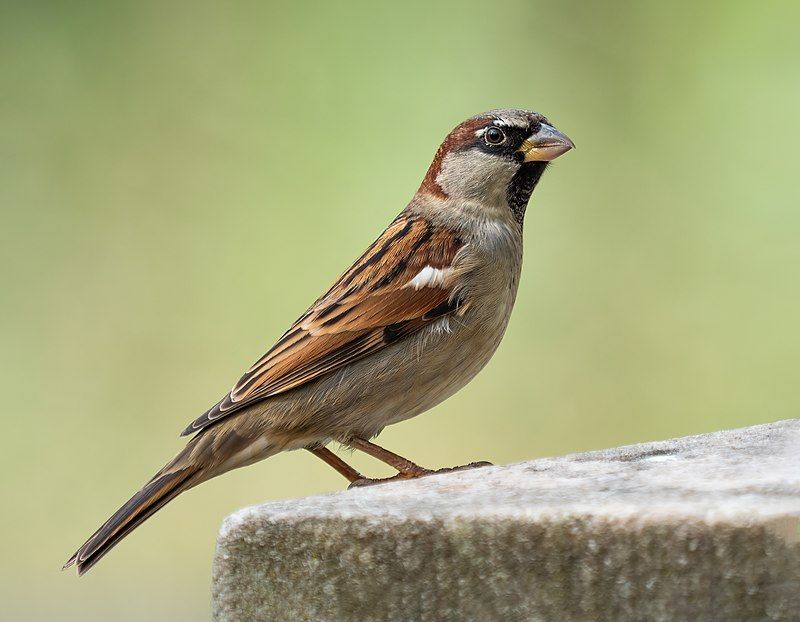
The House Sparrow, introduced to North America from Europe, is now one of the most common birds in urban and suburban areas.
Males have a distinctive black bib, white cheeks, a gray crown, and a rufous neck, while females are plain brown with streaked backs. These small, robust birds are highly adaptable and often found near human-made structures.
They are social and often seen in noisy flocks. House Sparrows primarily feed on seeds and human-provided food, and they can be aggressive toward other birds at feeders.
| Kingdom | Animalia |
| Phylum | Chordata |
| Clade | Dinosauria |
| Class | Aves |
| Order | Passeriformes |
| Family | Passeridae |
| Genus | Passer |
| Species | P. domesticus |
15. Bufflehead (Bucephala albeola)
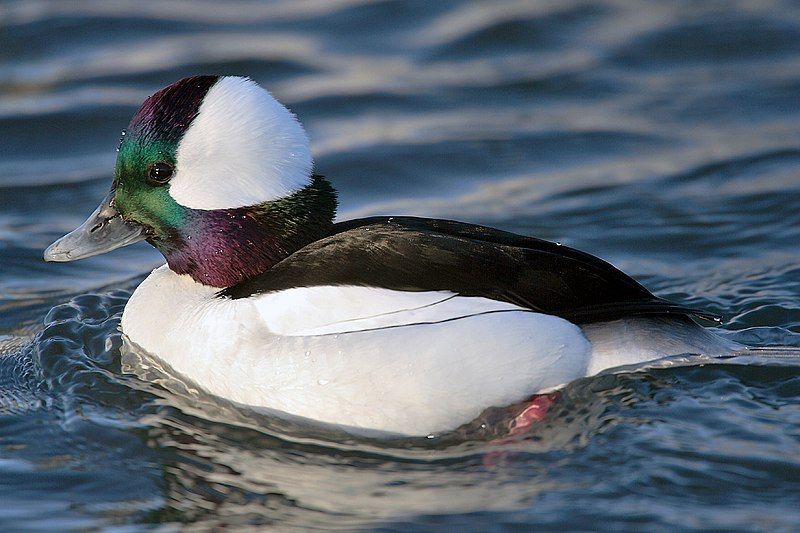
The Bufflehead is a small, striking waterfowl known for its bold black and white plumage in males, with a large white patch on the back of the head. Females are more subdued, with grayish-brown bodies and a smaller white cheek patch.
Buffleheads are diving ducks, feeding on aquatic invertebrates. They are found on lakes, ponds, and bays in North America, often in small flocks. They are known for their buoyant, bobbing motion on the water.
During the breeding season, they nest in tree cavities, often those made by Northern Flickers. Buffleheads are swift fliers and migrate long distances between their breeding and wintering grounds.
| Kingdom | Animalia |
| Phylum | Chordata |
| Clade | Dinosauria |
| Class | Aves |
| Order | Anseriformes |
| Family | Anatidae |
| Genus | Bucephala |
| Species | B. albeola |
16. Tundra Swan (Cygnus columbianus)
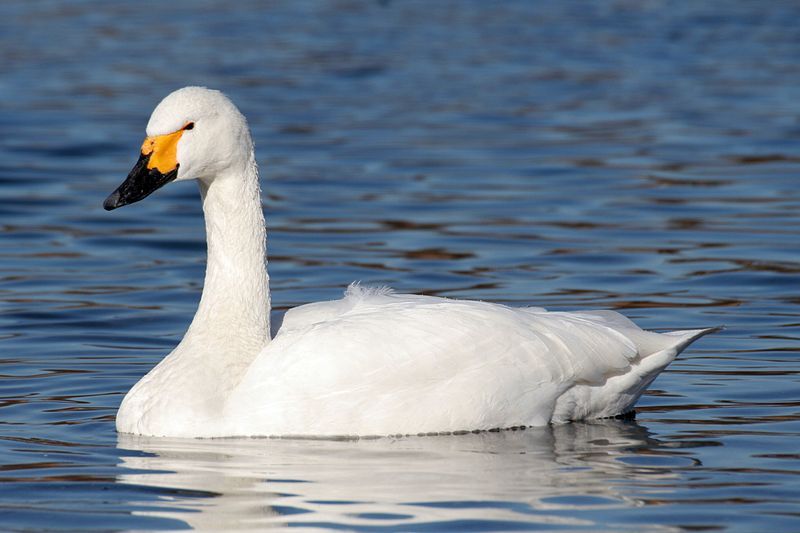
The Tundra Swan, formerly known as the Whistling Swan, is a large, elegant bird, recognized for its all-white plumage and long, graceful neck.
Adults have a black bill with a small yellow spot near the eye, which distinguishes them from the similar Trumpeter Swan. These swans breed in the Arctic tundra and migrate to coastal and southern freshwater marshes in winter.
During migration, their impressive V-shaped flocks and melodic, whistling calls are notable. Tundra Swans are herbivores, feeding on aquatic vegetation, roots, and tubers. They are often seen in family groups and are known for their strong pair bonds.
| Kingdom | Animalia |
| Phylum | Chordata |
| Clade | Dinosauria |
| Class | Aves |
| Order | Anseriformes |
| Family | Anatidae |
| Genus | Cygnus |
| Species | C. columbianus |
17. American Robin (Turdus migratorius)
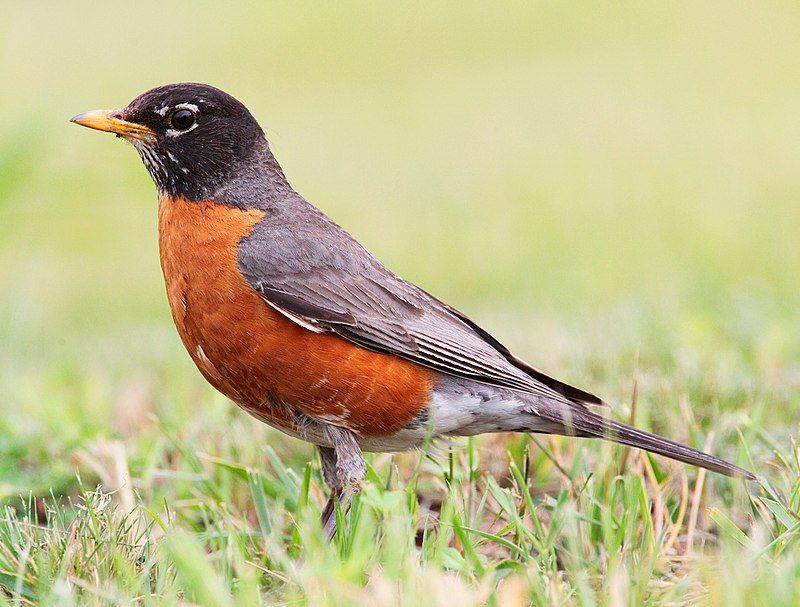
The American Robin is a familiar sight in gardens, parks, and yards across North America. Known for their bright orange-red breast, gray upperparts, and white throat with dark streaks, they are among the first birds to sing at dawn.
Robins are versatile feeders; they eat a wide variety of insects and worms in the summer and switch to fruits and berries in the fall and winter.
They are known for their running and stopping behavior on lawns as they hunt for earthworms. American Robins are migratory, with some populations moving southward in winter.
| Kingdom | Animalia |
| Phylum | Chordata |
| Clade | Dinosauria |
| Class | Aves |
| Order | Passeriformes |
| Family | Turdidae |
| Genus | Turdus |
| Species | T. migratorius |
18. Common Starling (Sturnus vulgaris)
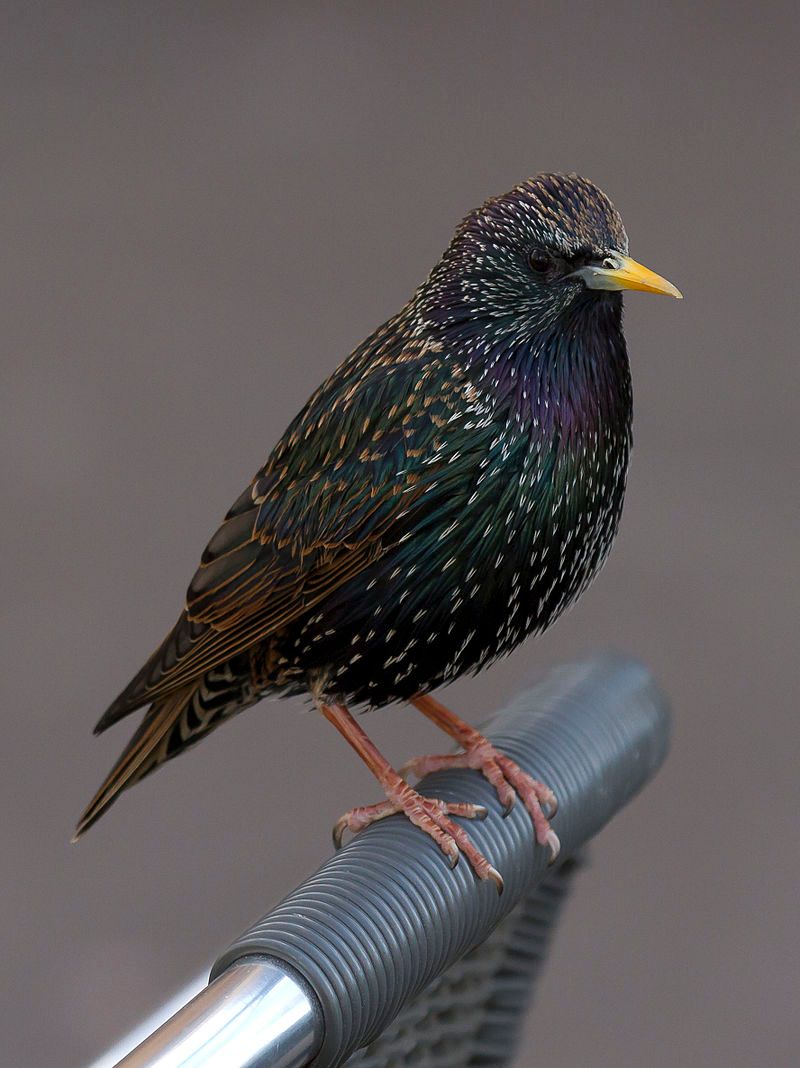
The Common Starling, an introduced species in North America, is easily recognized by its iridescent black plumage with speckles of white or buff. In winter, the speckles are more pronounced.
They have a yellow bill in breeding season and a dark bill otherwise. Starlings are highly social and often form large, noisy flocks.
They are adaptable and thrive in urban and rural areas, often displacing native cavity-nesting birds.
Their diet includes insects, fruits, and human-provided food. Starlings are also known for their mimicry of other bird species and mechanical sounds.
| Kingdom | Animalia |
| Phylum | Chordata |
| Clade | Dinosauria |
| Class | Aves |
| Order | Passeriformes |
| Family | Sturnidae |
| Genus | Sturnus |
| Species | S. vulgaris |
19. Eastern Bluebird (Sialia sialis)
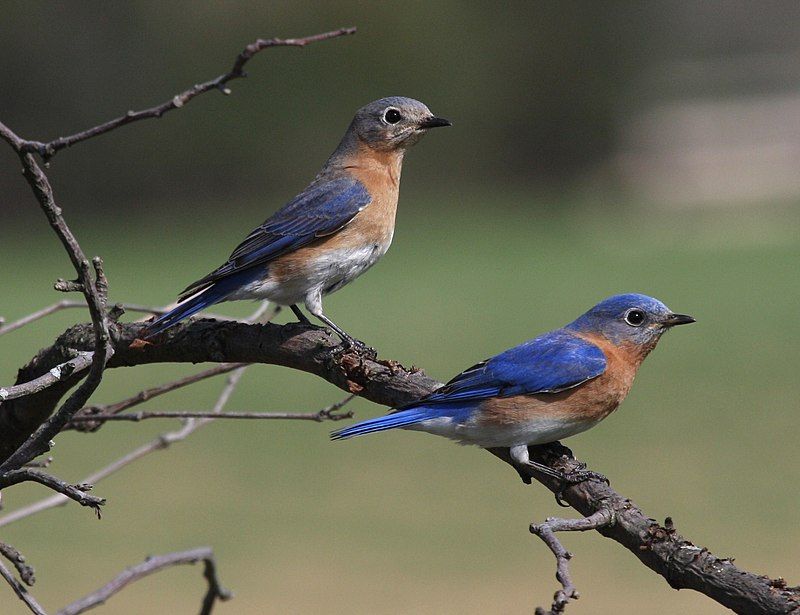
The Eastern Bluebird is a small, beautiful bird with a bright blue back and rusty red throat and chest. Females are more subdued with grayish-blue wings and tails and a lighter underbelly.
They inhabit open woodlands, farmlands, and orchards in eastern North America. Eastern Bluebirds are cavity nesters, often relying on nest boxes provided by humans.
Their diet consists mainly of insects and berries. Known for their gentle and melodious song, they are a symbol of happiness and renewal in many cultures.
| Kingdom | Animalia |
| Phylum | Chordata |
| Clade | Dinosauria |
| Class | Aves |
| Order | Passeriformes |
| Family | Turdidae |
| Genus | Sialia |
| Species | S. sialis |
20. Northern Mockingbird (Mimus polyglottos)
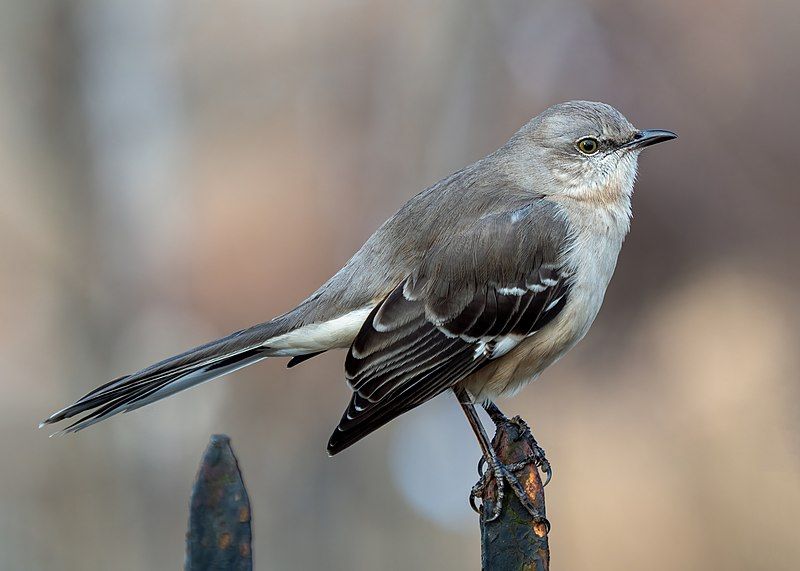
The Northern Mockingbird is famous for its vocal abilities; it can mimic the songs of over 200 different bird species, as well as other sounds it hears.
This medium-sized bird has a gray body, darker wings with white patches, and a long tail. They are common in open and semi-open areas across southern and eastern North America.
Northern Mockingbirds are omnivorous, eating insects, berries, and seeds. They are bold and territorial, often seen perched on high branches, singing for extended periods, or defending their territory with vigor.
| Kingdom | Animalia |
| Phylum | Chordata |
| Clade | Dinosauria |
| Class | Aves |
| Order | Passeriformes |
| Family | Mimidae |
| Genus | Mimus |
| Species | M. polyglottos |
21. American Crow (Corvus brachyrhynchos)
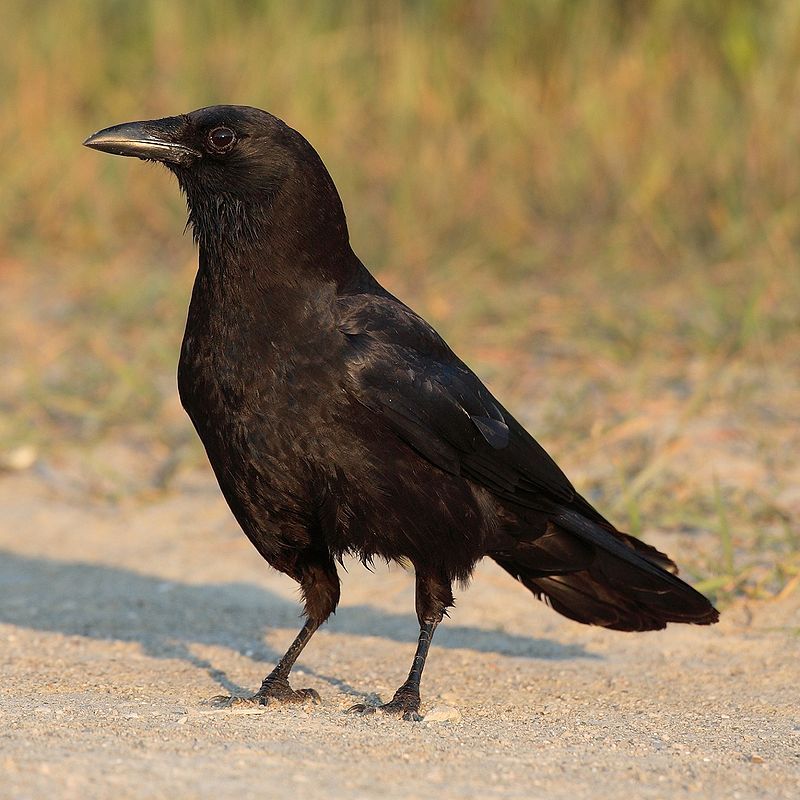
The American Crow is a large, intelligent, and adaptable bird, well-known for its all-black plumage and distinctive cawing call. These birds exhibit remarkable problem-solving skills and are known to use tools.
Found across North America, they adapt well to various habitats including forests, fields, and urban areas. American Crows are highly social, often forming large roosts in winter.
Their diet is diverse, including insects, seeds, fruits, small animals, and garbage. They are also known to follow predators like owls and hawks to scavenge leftovers.
Crows play an important role in ecosystem dynamics as both predators and scavengers.
| Kingdom | Animalia |
| Phylum | Chordata |
| Clade | Dinosauria |
| Class | Aves |
| Order | Passeriformes |
| Family | Corvidae |
| Genus | Corvus |
| Species | C. brachyrhynchos |
22. Carolina Wren (Thryothorus ludovicianus)
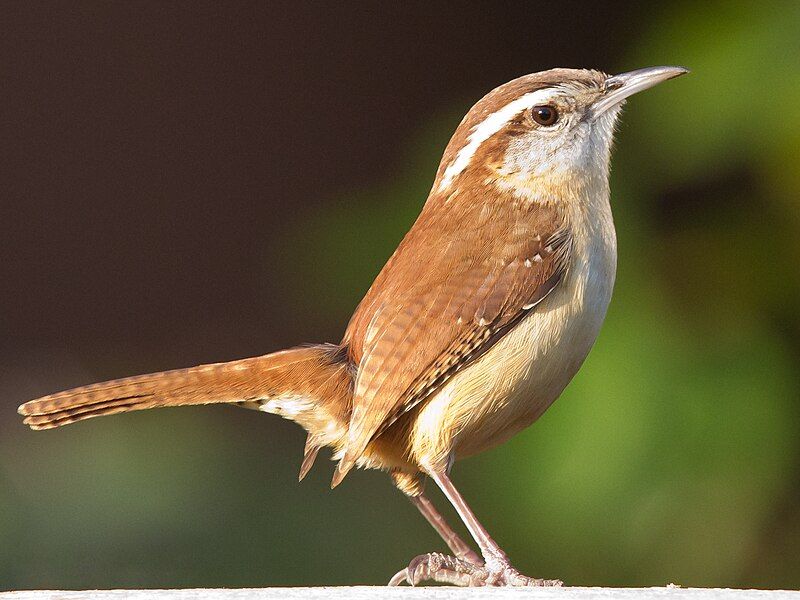
The Carolina Wren is a small but energetic bird, with a warm brown back, buff-colored underside, and a distinct white eyebrow stripe.
Known for its loud and melodious song, which sounds like “teakettle-teakettle-teakettle,” this bird is a common resident in the southeastern United States.
It prefers dense cover in wooded areas, gardens, and shrublands. The Carolina Wren is an active forager, often seen hopping around in search of insects, spiders, and berries.
Despite its small size, it has a bold personality and is known to be curious about humans.
| Kingdom | Animalia |
| Phylum | Chordata |
| Clade | Dinosauria |
| Class | Aves |
| Order | Passeriformes |
| Family | Troglodytidae |
| Genus | Thryothorus |
| Species | T. ludovicianus |
23. Ruby-Crowned Kinglet (Regulus calendula)
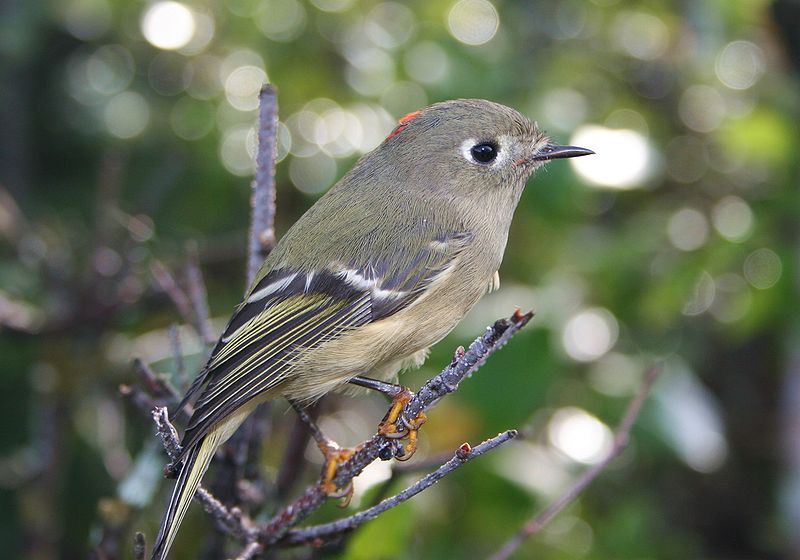
The Ruby-Crowned Kinglet is a tiny, energetic bird, identifiable by its olive-green plumage, prominent white eye-ring, and wing bars. The male has a hidden red crown patch, which is visible only when the bird is excited.
These birds are found in forests and woodlands across North America, often flitting about in search of insects and spiders.
Ruby-Crowned Kinglets are known for their constant motion and high-pitched, complex song. Despite their small size, they are hardy, enduring cold temperatures during migration and in their wintering habitats.
| Kingdom | Animalia |
| Phylum | Chordata |
| Clade | Dinosauria |
| Class | Aves |
| Order | Passeriformes |
| Family | Regulidae |
| Genus | Corthylio |
| Species | C. calendula |
24. Orange-Crowned Warbler (Leiothlypis celata)
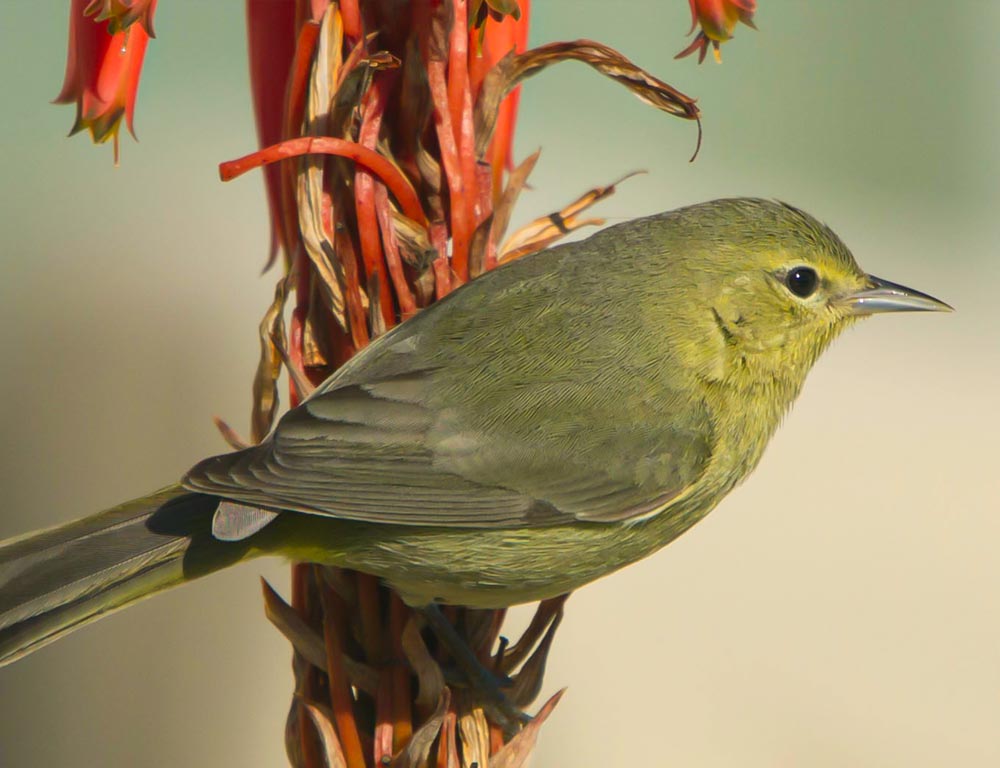
The Orange-Crowned Warbler is a small, often overlooked bird due to its subtle olive-green plumage and faintly streaked underparts. The orange crown patch is rarely seen.
These warblers are widespread across North America, inhabiting shrubby areas and open woodlands. They are insectivorous, primarily feeding on caterpillars, beetles, and spiders.
During migration, they can be found in various habitats, including gardens and parks. Their song is a sweet trill, similar to that of the Chipping Sparrow but more variable in pitch.
| Kingdom | Animalia |
| Phylum | Chordata |
| Clade | Dinosauria |
| Class | Aves |
| Order | Passeriformes |
| Family | Parulidae |
| Genus | Leiothlypis |
| Species | L. celata |
25. Common Loon (Gavia immer)
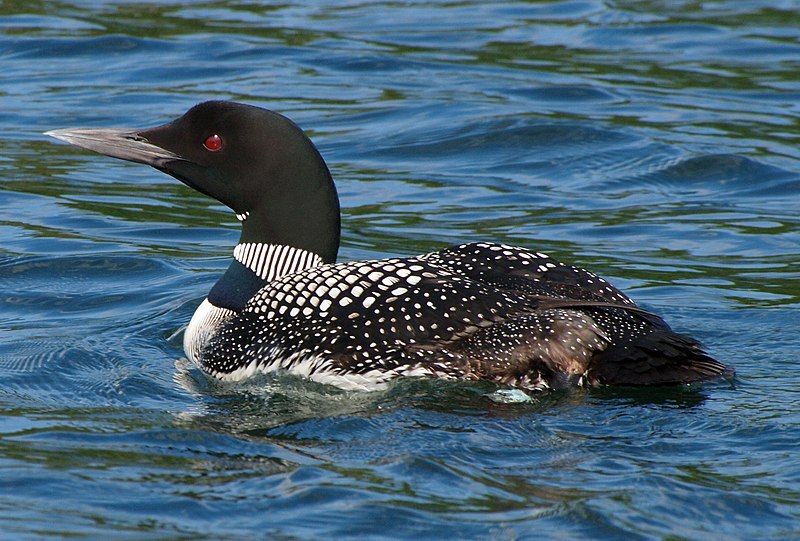
The Common Loon is a large, iconic water bird known for its striking black-and-white checkered back and piercing red eyes. In winter, they have a more muted grayish plumage.
Loons are famous for their eerie, haunting calls, which echo across northern lakes where they breed. They are excellent divers, feeding on fish, which they catch underwater with their sharp bills.
Loons are found on freshwater lakes and reservoirs in Canada and the northern United States during summer, migrating to coastal waters in winter.
Their powerful, streamlined bodies are adapted for efficient swimming, but make it cumbersome for them to move on land.
| Kingdom | Animalia |
| Phylum | Chordata |
| Clade | Dinosauria |
| Class | Aves |
| Order | Gaviiformes |
| Family | Gaviidae |
| Genus | Gavia |
| Species | G. immer |
26. Snow Goose (Anser caerulescens)
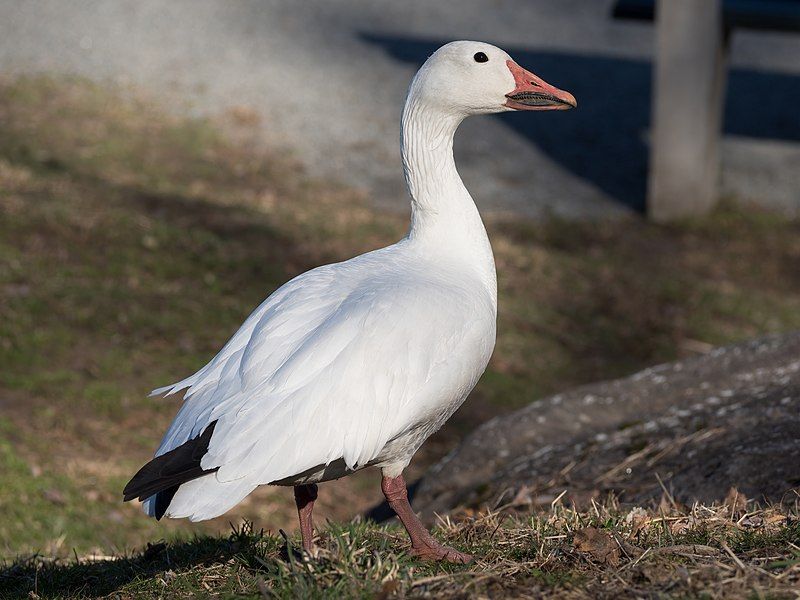
The Snow Goose is a stunning bird, known for its white plumage and black wingtips. They exhibit a color morph known as the “Blue Goose,” which has bluish-gray plumage with a white head.
These birds breed in the Arctic tundra and migrate in large, noisy flocks to warmer regions in the United States during winter. Snow Geese are herbivores, feeding on plant material, and are often seen grazing in fields.
Their migration is spectacular, with flocks numbering in the thousands, creating impressive displays in the sky. They have a strong social structure and are known for their lifelong pair bonds.
| Kingdom | Animalia |
| Phylum | Chordata |
| Clade | Dinosauria |
| Class | Aves |
| Order | Anseriformes |
| Family | Anatidae |
| Genus | Anser |
| Species | A. caerulescens |
27. Northern Flicker (Colaptes auratus)
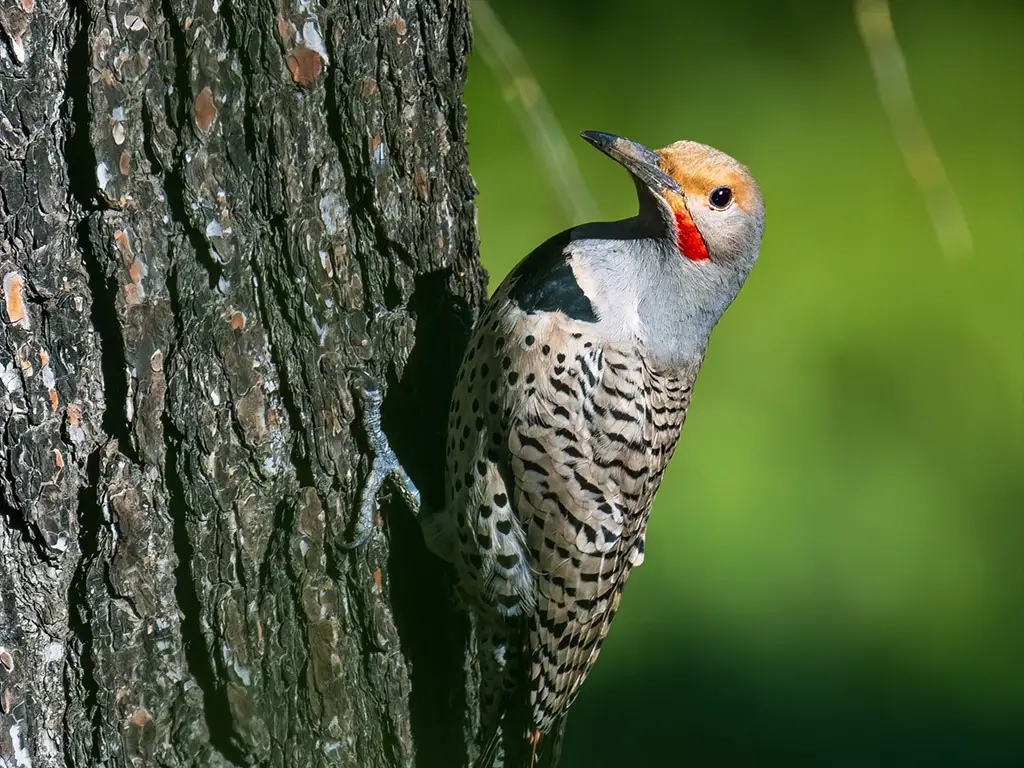
The Northern Flicker is a medium-sized woodpecker with a brown barred back, black-spotted underparts, and a distinctive white rump patch visible in flight.
There are two color forms: the yellow-shafted in the east and north, and the red-shafted in the west. Both males and females have a conspicuous black ‘mustache’; however, it is red in the red-shafted form and black in the yellow-shafted.
Flickers are ground foragers, primarily eating ants and beetles. They are known for their loud calls and drumming on metal surfaces. These birds are found in open habitats near trees, including woodlands, edges, and backyards.
| Kingdom | Animalia |
| Phylum | Chordata |
| Clade | Dinosauria |
| Class | Aves |
| Order | Piciformes |
| Family | Picidae |
| Genus | Colaptes |
| Species | C. auratus |
28. American Wigeon (Mareca americana)
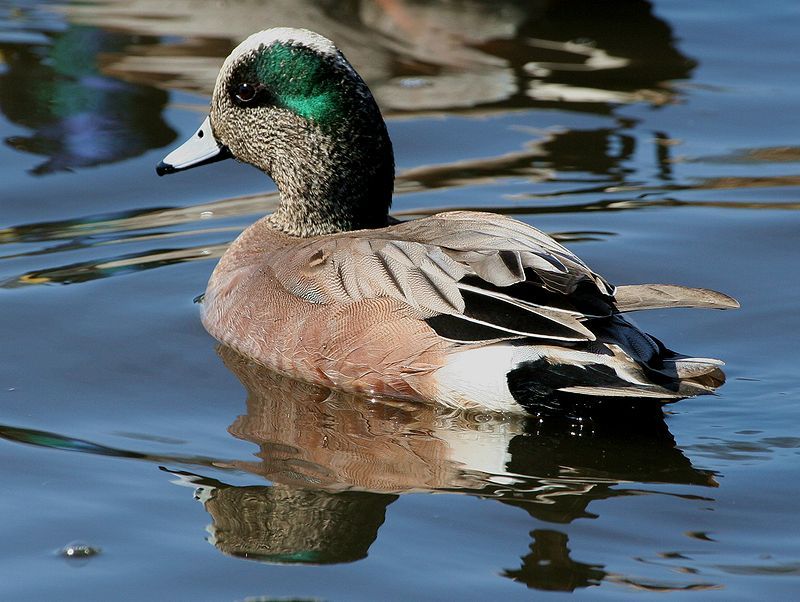
The American Wigeon is a medium-sized, attractive duck with a unique whistle-like call. Males have a distinctive white forehead, a green stripe through the eye, and a pale blue bill; females are mottled brown with a grayish head.
They are commonly found in ponds, marshes, and estuaries. American Wigeons are known for their grazing habits, often seen on land nibbling grass, which is unusual for ducks.
They also engage in ‘kleptoparasitism,’ stealing food from other ducks. During migration, they form large flocks and can be quite social.
| Kingdom | Animalia |
| Phylum | Chordata |
| Clade | Dinosauria |
| Class | Aves |
| Order | Anseriformes |
| Family | Anatidae |
| Genus | Mareca |
| Species | M. americana |
29. Yellow-Rumped Warbler (Setophaga coronata)
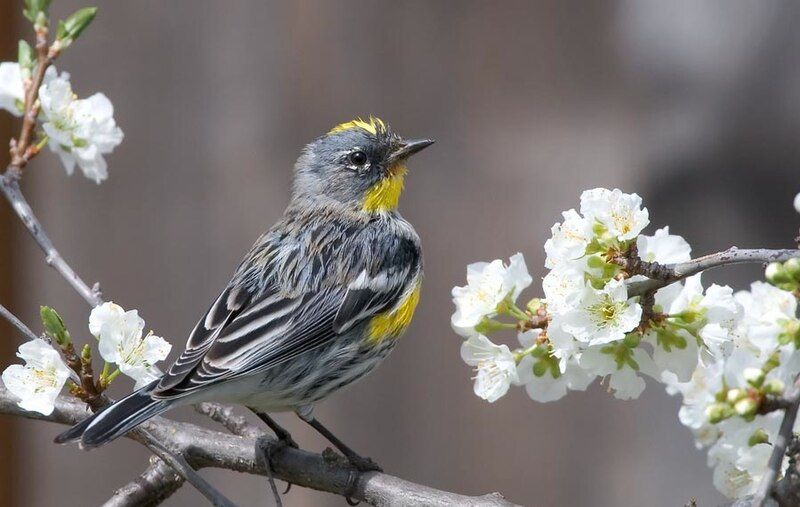
The Yellow-Rumped Warbler often called the “Butterbutt” for its bright yellow rump patch, is one of the most widespread and versatile warblers in North America.
They have striking plumage with a mix of gray, black, white, and yellow patches on the face, sides, and rump. These birds are adaptable and found in a variety of habitats including forests, shrublands, and parks.
They primarily eat insects but switch to berries in colder months, allowing them to winter further north than other warblers. Their song is a simple trill, and they have a distinctive check call.
| Kingdom | Animalia |
| Phylum | Chordata |
| Clade | Dinosauria |
| Class | Aves |
| Order | Passeriformes |
| Family | Parulidae |
| Genus | Setophaga |
| Species | S. coronata |
30. Northern Pintail (Anas acuta)
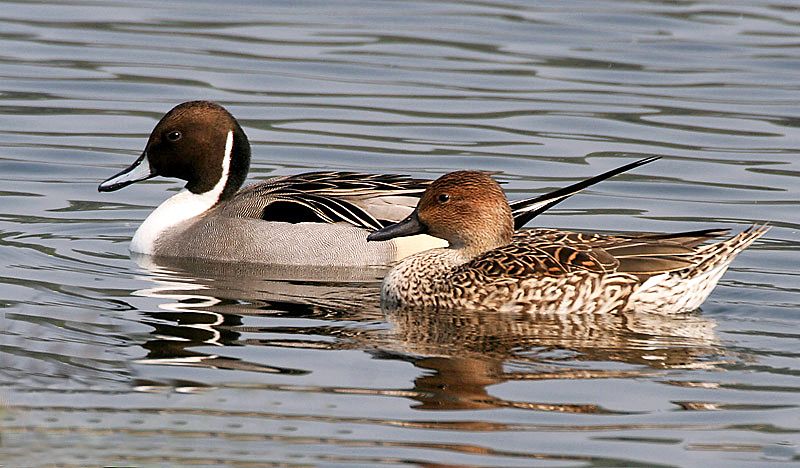
The Northern Pintail is a graceful duck with a long, pointed tail, giving it a distinctive silhouette. Males have chocolate-brown head, white breast, and gray body, while females are mottled brown.
They are often seen in open wetlands, marshes, and agricultural fields. Pintails are dabbling ducks, feeding on the water surface, or tipping up to reach aquatic plants and invertebrates.
They are known for their fast, agile flight and are long-distance migrants. Northern Pintails have a gentle, rolling call and are often found in mixed flocks with other waterfowl.
| Kingdom | Animalia |
| Phylum | Chordata |
| Clade | Dinosauria |
| Class | Aves |
| Order | Anseriformes |
| Family | Anatidae |
| Genus | Anas |
| Species | A. acuta |
31. American Coot (Fulica americana)
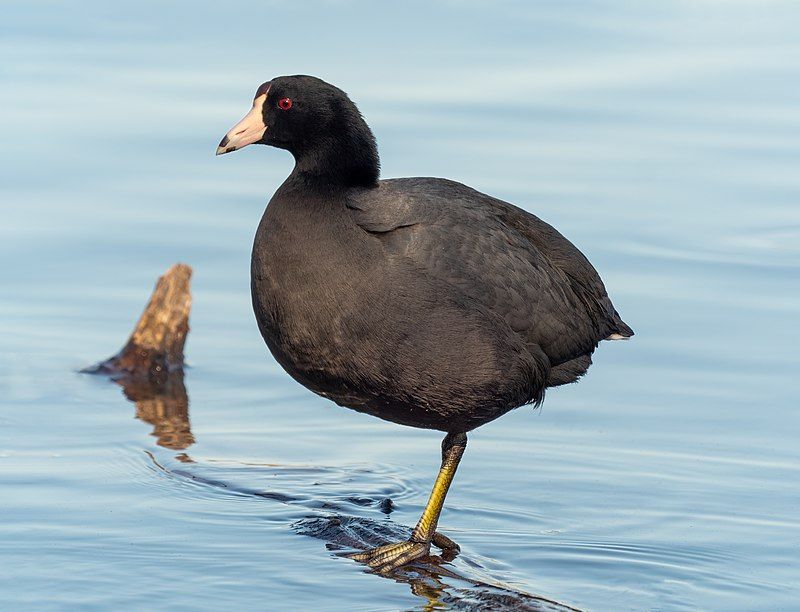
The American Coot is a distinctive waterbird with a dark gray to black body, a white bill, and a white frontal shield above the bill. Despite being duck-like in appearance, coots are more closely related to rails and cranes.
They have unique lobed feet, not webbed like ducks, which aid in swimming and walking on soft mud. American Coots are commonly found in ponds, lakes, and marshes across North America.
They are aggressive and territorial during the breeding season, displaying interesting courtship rituals.
Their diet primarily consists of aquatic plants, insects, and small fish. Coots are known for their loud, cackling calls and are often seen in large flocks, especially in winter.
| Kingdom | Animalia |
| Phylum | Chordata |
| Clade | Dinosauria |
| Class | Aves |
| Order | Gruiformes |
| Family | Rallidae |
| Genus | Fulica |
| Species | F. americana |
32. Wrens (Family Troglodytidae)
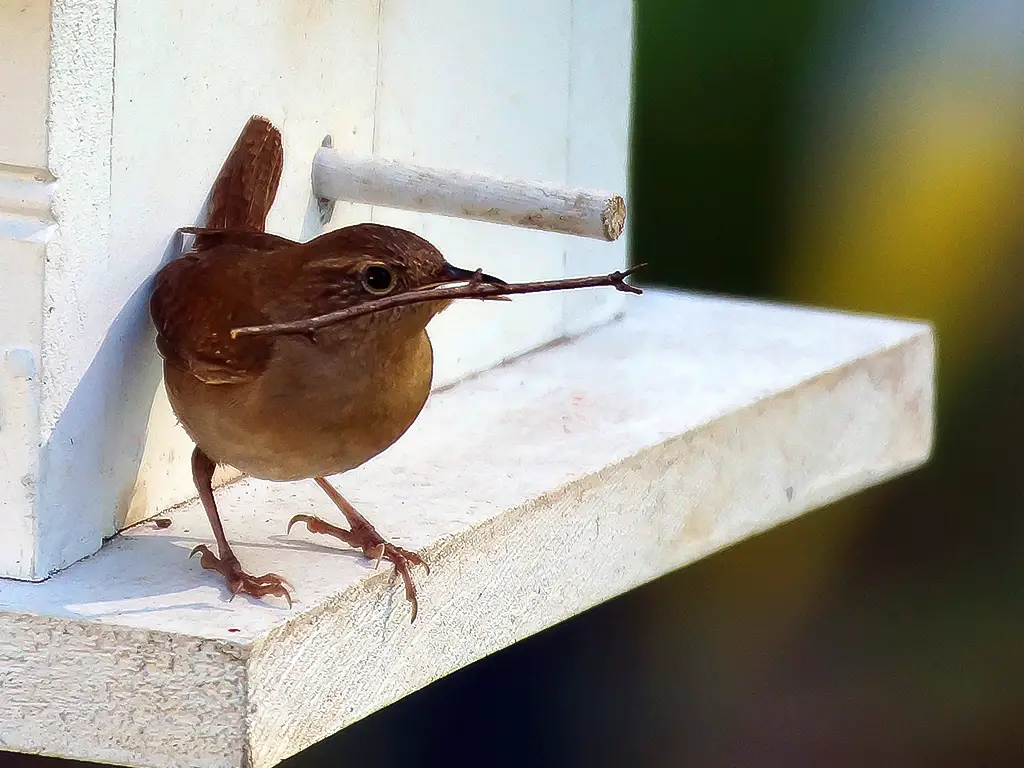
Wrens are small, active songbirds known for their loud and often complex songs. They have a distinctive upright tail, a round body, and a slightly curved bill.
Wrens are found in a variety of habitats including woods, gardens, and marshes. Species like the Carolina Wren and House Wren are common in North America.
These birds are insectivorous, but they also eat seeds and fruits. Wrens are curious and energetic, often exploring tree bark and crevices for food.
Their nests are unique, often dome-shaped, and they are known for building multiple “dummy” nests in addition to their main nest.
| Kingdom | Animalia |
| Phylum | Chordata |
| Clade | Dinosauria |
| Class | Aves |
| Order | Passeriformes |
| Family | Troglodytidae |
33. Redhead (Aythya americana)
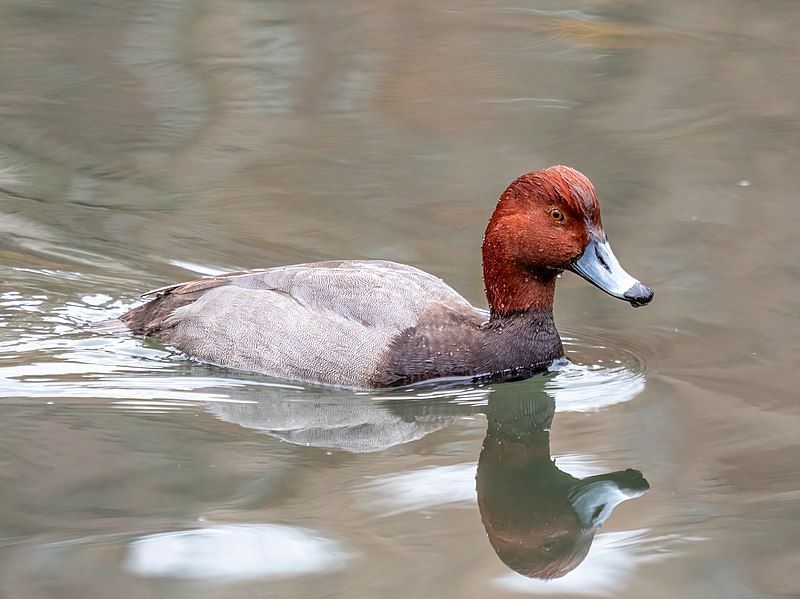
The Redhead is a striking diving duck, named for the male’s bright chestnut-red head and neck. Females are more subdued, with brownish bodies and a paler head.
They have a blue bill and a rounded head. Redheads are found in wetlands, lakes, and bays across North America, particularly during migration and in winter.
They feed by diving for aquatic plants, insects, and small fish. Redheads often nest in marshes and are known for laying their eggs in the nests of other ducks, especially Canvasbacks and Pintails. In flight, they form large flocks and are powerful, swift flyers.
| Kingdom | Animalia |
| Phylum | Chordata |
| Clade | Dinosauria |
| Class | Aves |
| Order | Anseriformes |
| Family | Anatidae |
| Genus | Aythya |
| Species | A. americana |
34. Pacific Loon (Gavia pacifica)
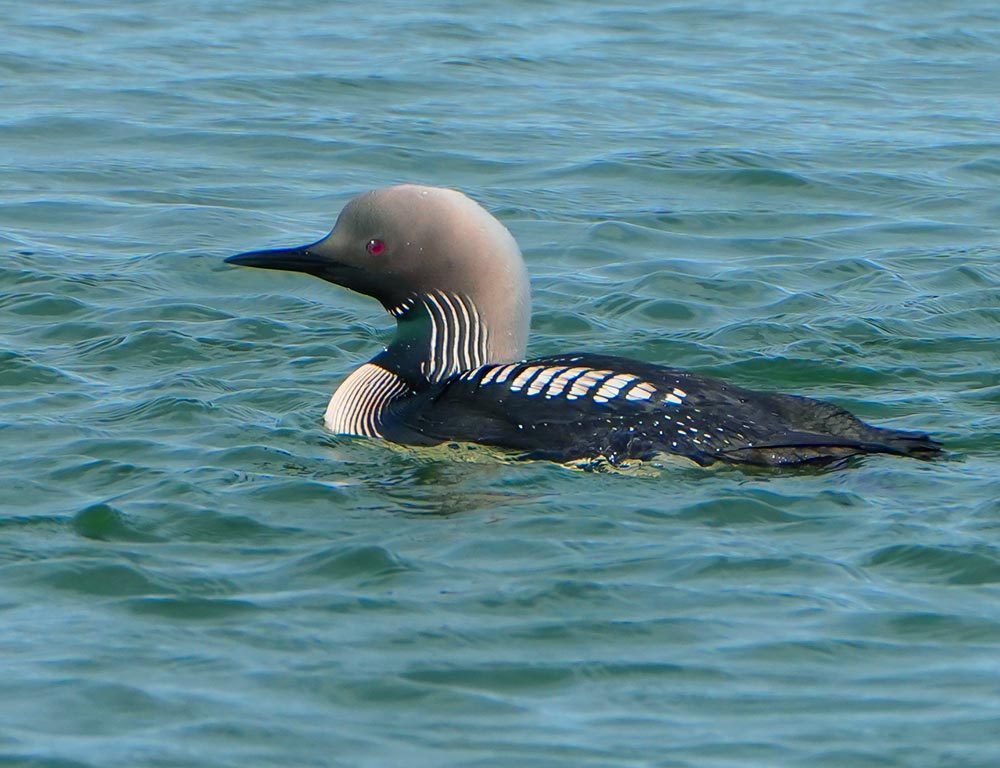
The Pacific Loon is a sleek, elegant waterbird known for its striking breeding plumage, which includes a black head, a checkered black-and-white back, and a black bill.
In winter, they have a more subdued gray and white appearance. Pacific Loons breed in the Arctic tundra and winter along the Pacific coast, from Alaska to Mexico.
They are expert divers, feeding mainly on fish and invertebrates. Their call is a haunting, yodel-like sound, most often heard during the breeding season.
Pacific Loons are less social than other loon species and are typically seen alone or in small groups.
| Kingdom | Animalia |
| Phylum | Chordata |
| Clade | Dinosauria |
| Class | Aves |
| Order | Gaviiformes |
| Family | Gaviidae |
| Genus | Gavia |
| Species | G. pacifica |
35. Harlequin Duck (Histrionicus histrionicus)
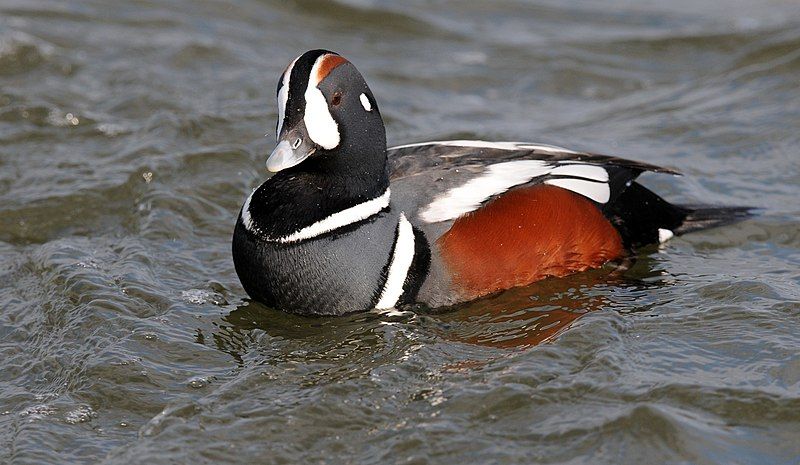
The Harlequin Duck is a small sea duck known for its striking and colorful plumage in males, featuring bold patterns of blue, black, white, and chestnut.
Females are more subdued with gray-brown bodies and a white spot near the eye. These ducks are found along rocky coastlines of the North Atlantic and North Pacific, and they breed on fast-flowing streams and rivers.
Harlequin Ducks are strong swimmers, adept at navigating rough waters. Their diet consists mainly of aquatic insects, mollusks, and crustaceans.
They have a soft, squeaky call and are often seen in small, tightly-knit groups. The Harlequin Duck is admired for its rugged beauty and unique habitat preferences.
| Kingdom | Animalia |
| Phylum | Chordata |
| Clade | Dinosauria |
| Class | Aves |
| Order | Anseriformes |
| Family | Anatidae |
| Genus | Histrionicus |
| Species | H. histrionicus |
36. Canada Goose (Branta canadensis)
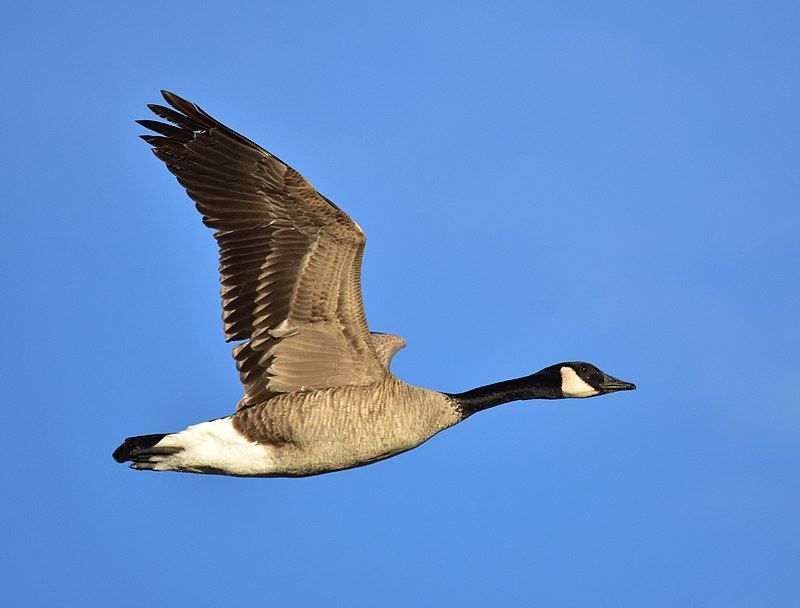
The Canada Goose is a large waterfowl recognized by its black head and neck, white cheeks, and long, black neck. Their brownish-gray body and large size make them easily identifiable.
These geese are found in a variety of habitats, including lakes, rivers, ponds, and sometimes urban parks.
They are known for their V-shaped flying formations and loud honking. Canada Geese are herbivores, primarily feeding on grass, grains, and aquatic plants.
They are highly social and often form large flocks. These geese are also known for their strong migratory instincts, traveling great distances during seasonal migrations.
| Kingdom | Animalia |
| Phylum | Chordata |
| Clade | Dinosauria |
| Class | Aves |
| Order | Anseriformes |
| Family | Anatidae |
| Genus | Branta |
| Species | B. canadensis |
37. Turkey Vulture (Cathartes aura)
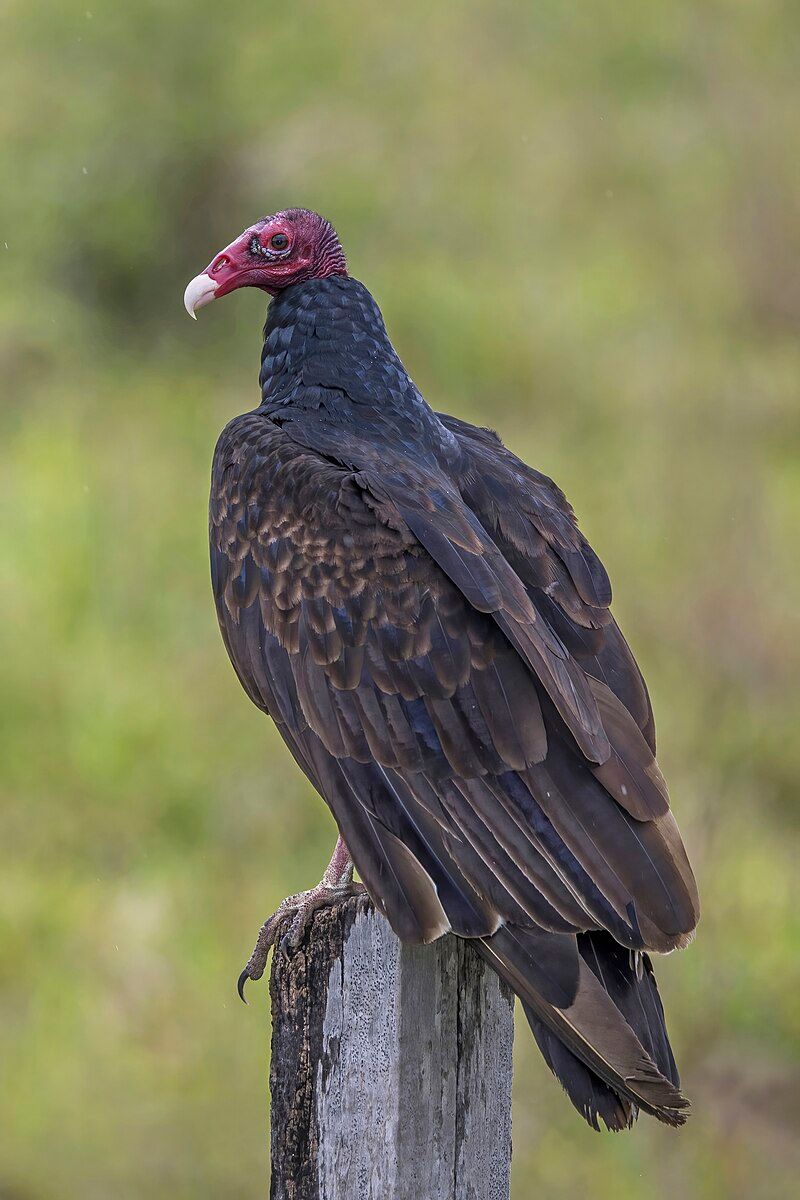
The Turkey Vulture is a large bird of prey, easily recognized by its bald, red head and dark body. In flight, its wings are held in a V-shape, and it soars gracefully with a few wingbeats.
These vultures are scavengers, feeding mostly on carrion, which they locate with their excellent sense of smell. They play a vital role in the ecosystem by cleaning up dead animals.
Turkey Vultures are found in a wide range of habitats, including forests, deserts, and suburban areas. They are known for their hissing and grunting sounds.
| Kingdom | Animalia |
| Phylum | Chordata |
| Clade | Dinosauria |
| Class | Aves |
| Order | Accipitriformes |
| Family | Cathartidae |
| Genus | Cathartes |
| Species | C. aura |
38. Ring-Billed Gull (Larus delawarensis)
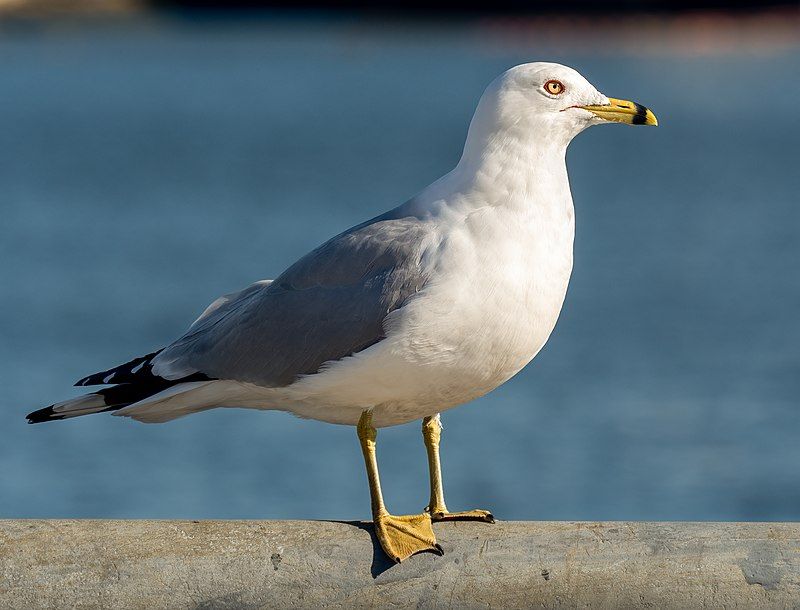
The Ring-Billed Gull is a medium-sized gull with a white body, gray wings, and a distinctive black ring around its yellow bill. They are commonly found in large flocks near lakes, rivers, beaches, and urban areas, often around people.
These gulls are opportunistic feeders, eating a wide variety of foods including fish, insects, and human refuse. They are known for their loud, cackling calls and acrobatic flight.
Ring-billed gulls are highly adaptable and are one of the most common gull species in North America.
| Kingdom | Animalia |
| Phylum | Chordata |
| Clade | Dinosauria |
| Class | Aves |
| Order | Charadriiformes |
| Family | Laridae |
| Genus | Larus |
| Species | L. delawarensis |
39. Hermit Thrush (Catharus guttatus)
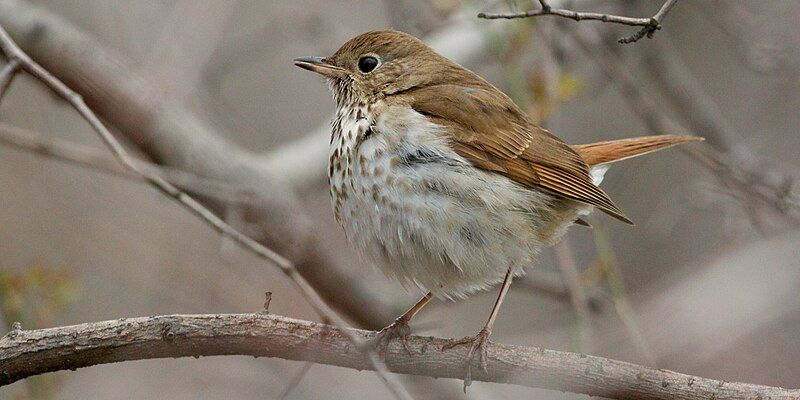
The Hermit Thrush is a small, solitary songbird with a reddish-brown tail, olive-brown upperparts, and a white, spotted underbelly. Known for its ethereal, flute-like song, the Hermit Thrush is often heard before it’s seen.
They inhabit forested areas and are more often found in dense underbrush. Their diet consists of insects and fruits. Hermit Thrushes are shy and elusive, but their melodious song makes them a favorite among bird enthusiasts.
| Kingdom | Animalia |
| Phylum | Chordata |
| Clade | Dinosauria |
| Class | Aves |
| Order | Passeriformes |
| Family | Turdidae |
| Genus | Catharus |
| Species | C. guttatus |
40. Brown Creeper (Certhia americana)
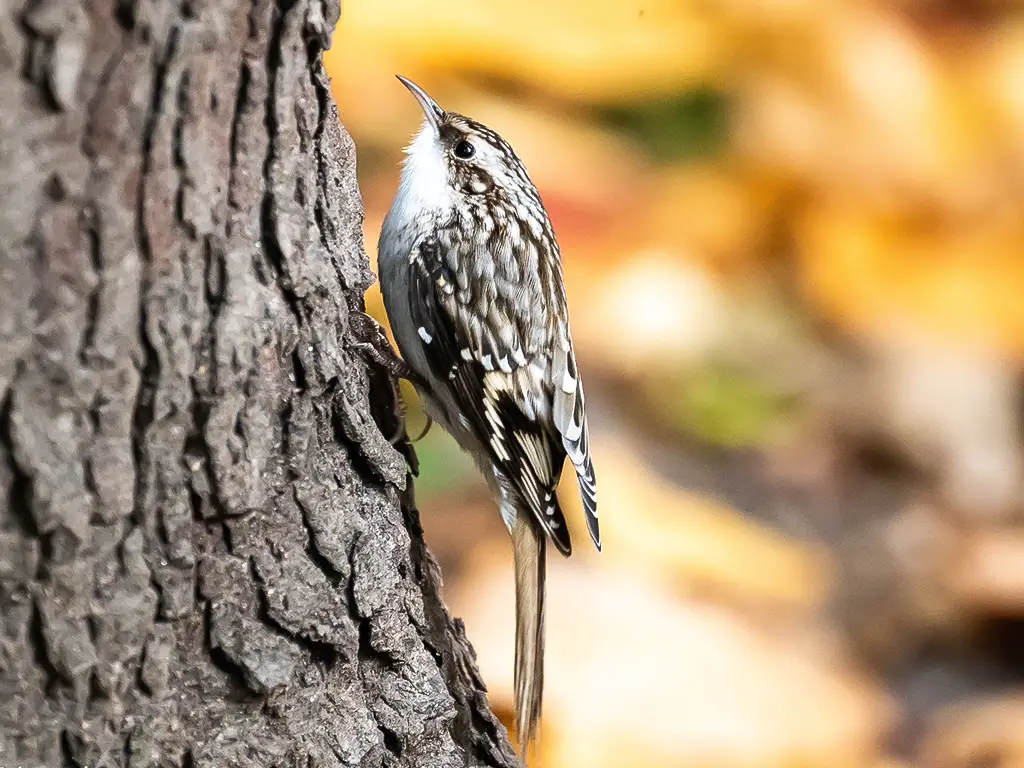
The Brown Creeper is a small, inconspicuous bird with mottled brown plumage, which camouflages it against tree bark. It has a slender, down-curved bill and a stiff tail, used for support as it climbs.
Brown Creepers spiral upwards around tree trunks, feeding on insects and spiders hidden in the bark.
They are found in wooded areas and forests. Their presence is often revealed by their high-pitched, thin call. Brown Creepers build their nests behind loose bark on trees, a unique trait among North American birds.
| Kingdom | Animalia |
| Phylum | Chordata |
| Clade | Dinosauria |
| Class | Aves |
| Order | Passeriformes |
| Family | Certhiidae |
| Genus | Certhia |
| Species | C. americana |
41. Yellow-Bellied Sapsucker (Sphyrapicus varius)
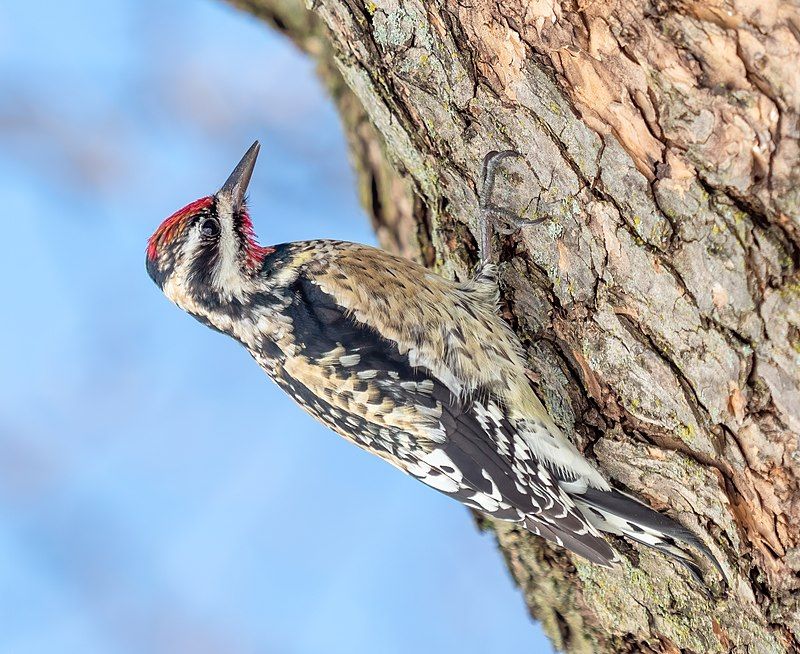
The Yellow-Bellied Sapsucker is a medium-sized woodpecker known for its distinctive habit of drilling rows of small holes in trees to feed on sap.
They have a black and white barred back, a red forehead, a white wing patch, and a yellowish wash on the belly. Males have a red throat while females have a white throat.
These birds are found in forests across the eastern United States and Canada. They also eat insects and fruit. Their sap-feeding habits are important for other wildlife, as these holes provide sap for other species and attract insects for feeding.
| Kingdom | Animalia |
| Phylum | Chordata |
| Clade | Dinosauria |
| Class | Aves |
| Order | Piciformes |
| Family | Picidae |
| Genus | Sphyrapicus |
| Species | S. varius |
42. Winter Wren (Troglodytes hiemalis)
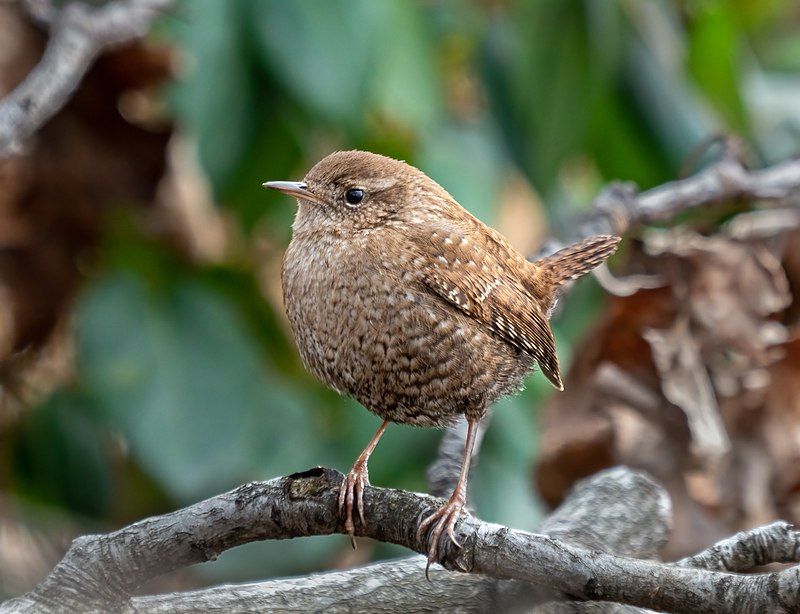
The Winter Wren is a tiny bird with a short tail, often held upright, and rich brown plumage with fine dark barring. It is known for its remarkably loud and melodious song, which can be heard in forests, thickets, and woodland areas where it resides.
These birds are energetic insectivores, foraging among dense underbrush for spiders and insects. Winter Wrens are often seen hopping around with a cocked tail, exploring every crevice and nook in their habitat.
| Kingdom | Animalia |
| Phylum | Chordata |
| Clade | Dinosauria |
| Class | Aves |
| Order | Passeriformes |
| Family | Troglodytidae |
| Genus | Troglodytes |
| Species | T. hiemalis |
43. Great Egret (Ardea alba)
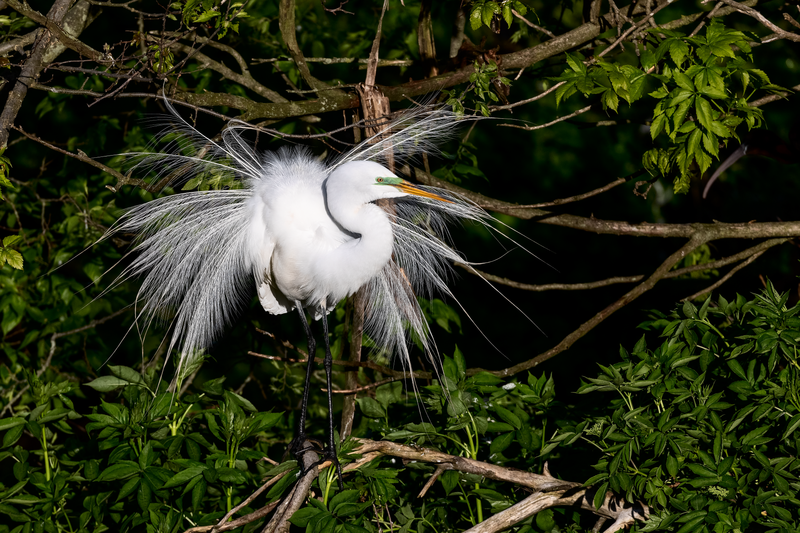
The Great Egret is a large, graceful waterbird with all-white plumage, a long neck, and long, black legs. During the breeding season, they develop long, ornamental plumes on their back.
Great Egrets are found near ponds, marshes, and rivers, where they hunt for fish, frogs, and other aquatic animals. They stand still in shallow water and spear prey with their sharp bill.
These egrets are also known for their spectacular courtship displays and are a symbol of the conservation movement, having recovered from near extinction.
| Kingdom | Animalia |
| Phylum | Chordata |
| Clade | Dinosauria |
| Class | Aves |
| Order | Pelecaniformes |
| Family | Ardeidae |
| Genus | Ardea |
| Species | A. alba |
44. Indigo Bunting (Passerina cyanea)
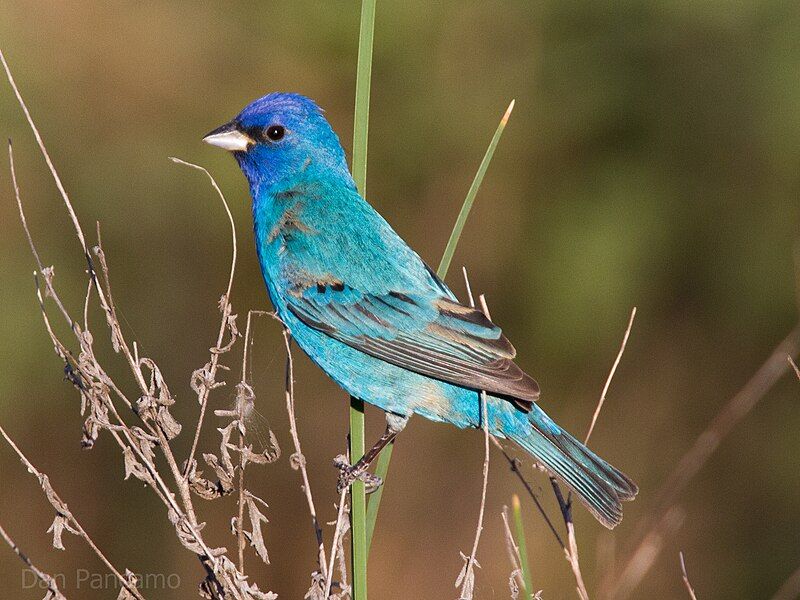
The Indigo Bunting is a small songbird with brilliant blue plumage in males, which appears almost glowing in sunlight. Females and young birds are brown with faint streaks.
They are commonly found in open wooded areas, edges of forests, and along roadsides. These birds feed on insects and seeds, often foraging on the ground.
The male’s song is a cheerful, high-pitched series of phrases, and they are known for singing from high perches.
| Kingdom | Animalia |
| Phylum | Chordata |
| Clade | Dinosauria |
| Class | Aves |
| Order | Passeriformes |
| Family | Cardinalidae |
| Genus | Passerina |
| Species | P. cyanea |
45. Mute Swan (Cygnus olor)
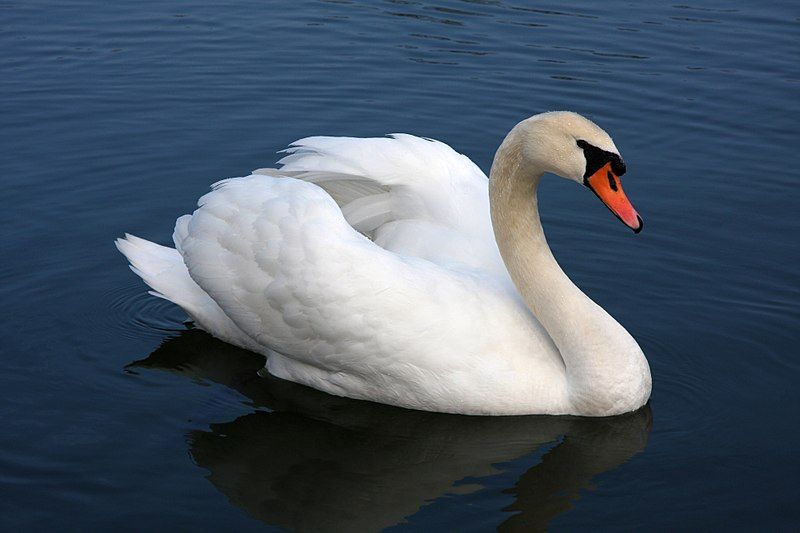
The Mute Swan is a large, elegant bird, famous for its S-shaped neck and white plumage. They have an orange bill with a black base and a prominent knob above the bill.
Despite their name, Mute Swans are not completely silent; they can make a variety of hissing and grunting sounds.
They are often found in lakes, ponds, and coastal areas, where they feed on aquatic vegetation, small fish, and insects. Mute Swans are known for their aggressive behavior in defending their nests.
| Kingdom | Animalia |
| Phylum | Chordata |
| Clade | Dinosauria |
| Class | Aves |
| Order | Anseriformes |
| Family | Anatidae |
| Genus | Cygnus |
| Species | C. olor |
46. Pileated Woodpecker (Dryocopus pileatus)
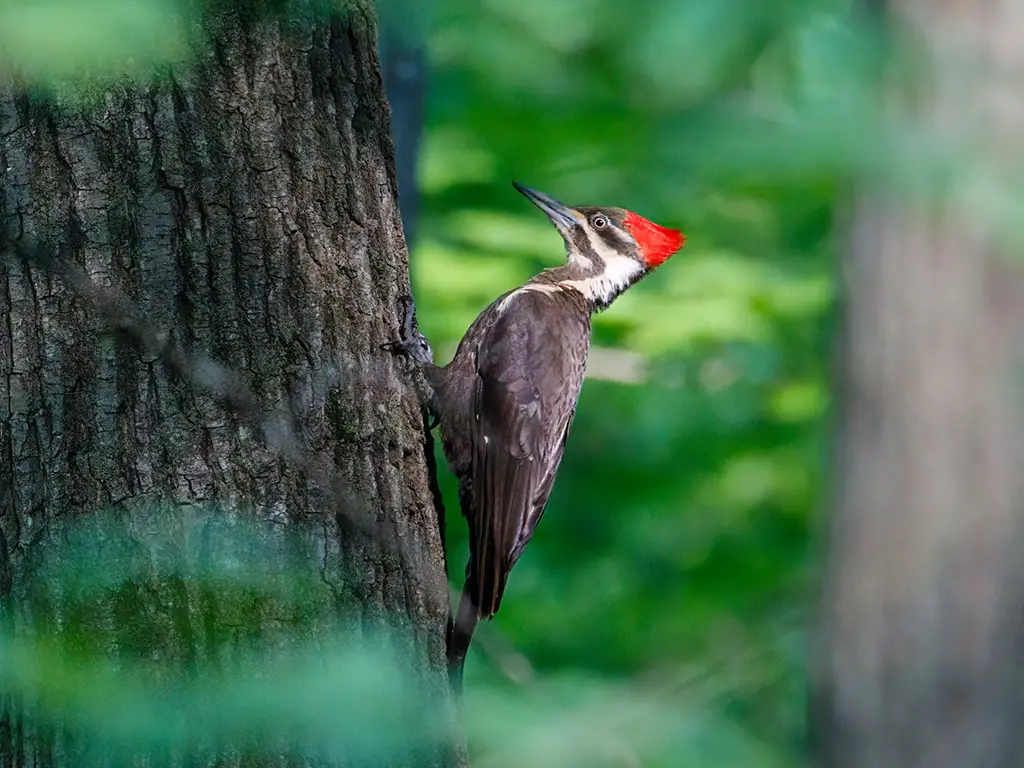
The Pileated Woodpecker is one of the largest woodpeckers in North America, easily recognized by its black body, white stripes on the face and neck, and a red crest. Males have a red stripe on their cheeks.
These birds are known for their loud call and powerful drumming on trees. They primarily feed on carpenter ants and wood-boring beetle larvae, excavating large, rectangular holes in trees.
Pileated Woodpeckers are found in mature forests and woodlands. They play a crucial role in their ecosystem, as their excavations provide nesting sites for various other species.
| Kingdom | Animalia |
| Phylum | Chordata |
| Clade | Dinosauria |
| Class | Aves |
| Order | Piciformes |
| Family | Picidae |
| Genus | Dryocopus |
| Species | D. pileatus |
47. Ruby-Throated Hummingbird (Archilochus colubris)
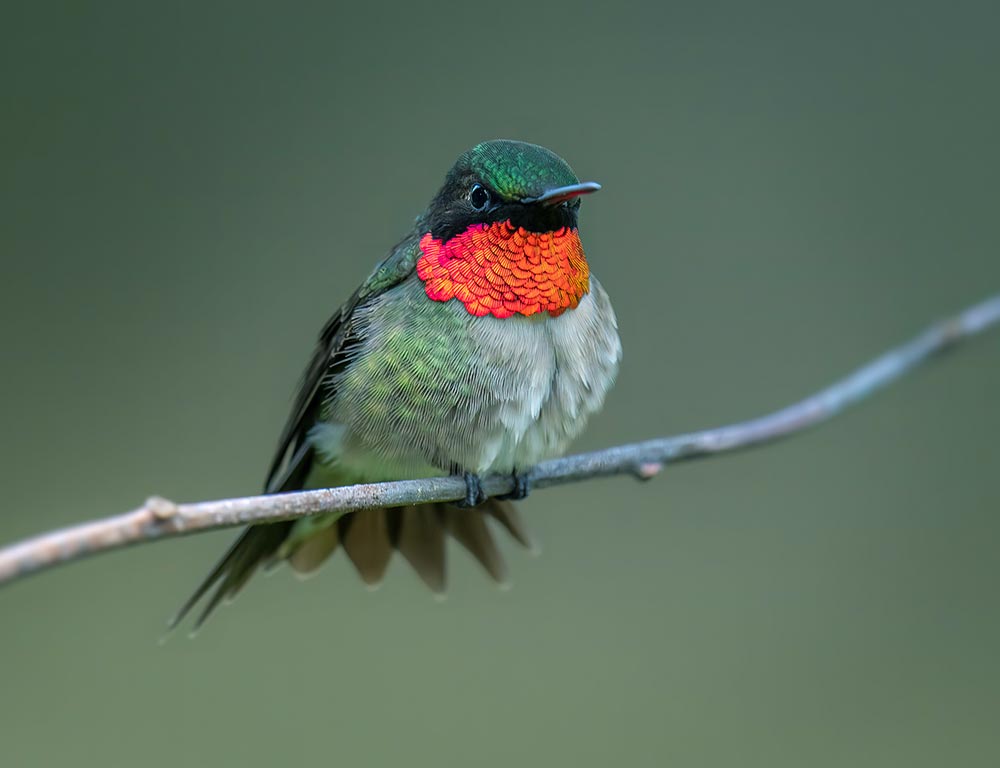
The Ruby-Throated Hummingbird, the only hummingbird species that breeds in the eastern United States, is renowned for its iridescent emerald-green back and a brilliant ruby-red throat in males.
Females are greenish above and whitish below with subtle throat markings. These tiny birds are incredible flyers, able to hover in place and even fly backward.
They feed primarily on nectar from flowers, using their long, slender bills and rapid wingbeats. They also eat small insects and spiders.
The migration of Ruby-Throated Hummingbirds is a remarkable feat, including a non-stop flight over the Gulf of Mexico.
| Kingdom | Animalia |
| Phylum | Chordata |
| Clade | Strisores |
| Class | Aves |
| Order | Apodiformes |
| Family | Trochilidae |
| Genus | Archilochus |
| Species | A. colubris |
48. American Bittern (Botaurus lentiginosus)
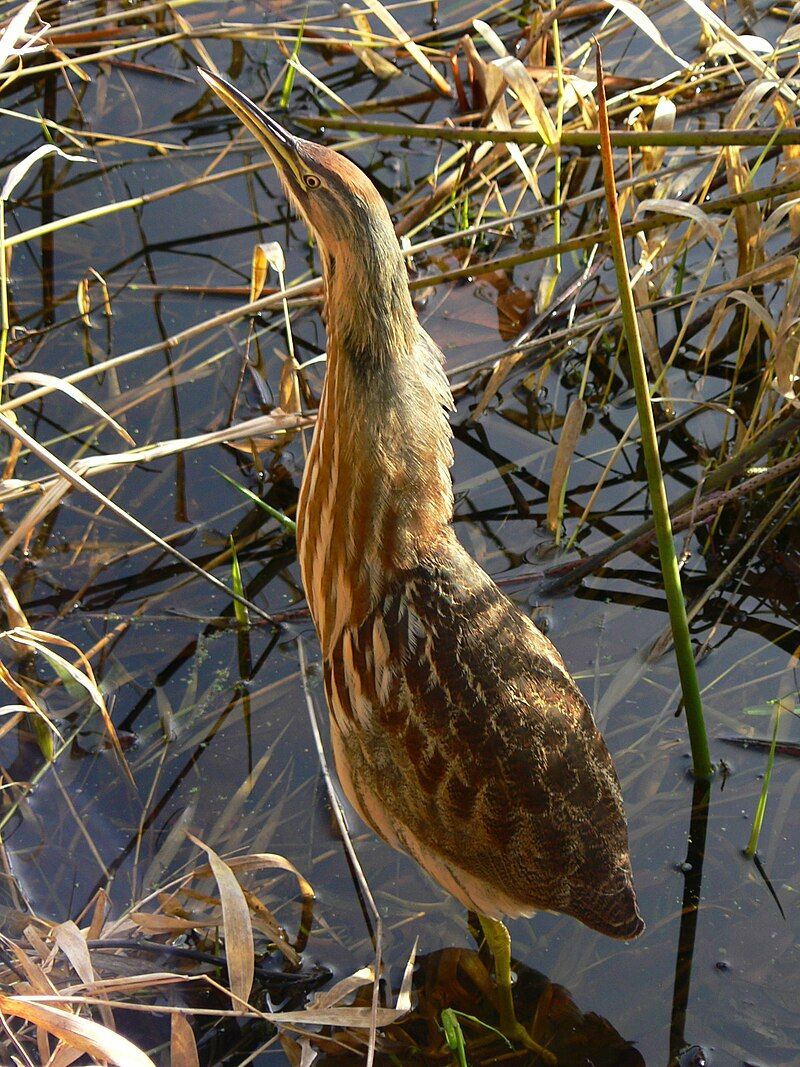
The American Bittern is a medium-sized heron with a stout body and streaked brown, tan, and white plumage, perfect for camouflage in its marshy habitat.
They are known for their unique, booming calls that sound like a distant pump. These secretive birds are found in freshwater marshes and wetlands, where they feed on fish, amphibians, and insects.
American Bitterns are solitary and elusive, often standing motionless with their beak pointed upwards, blending into the reeds.
| Kingdom | Animalia |
| Phylum | Chordata |
| Clade | Dinosauria |
| Class | Aves |
| Order | Pelecaniformes |
| Family | Ardeidae |
| Genus | Botaurus |
| Species | B. lentiginosus |
49. Cooper’s Hawk (Accipiter cooperii)
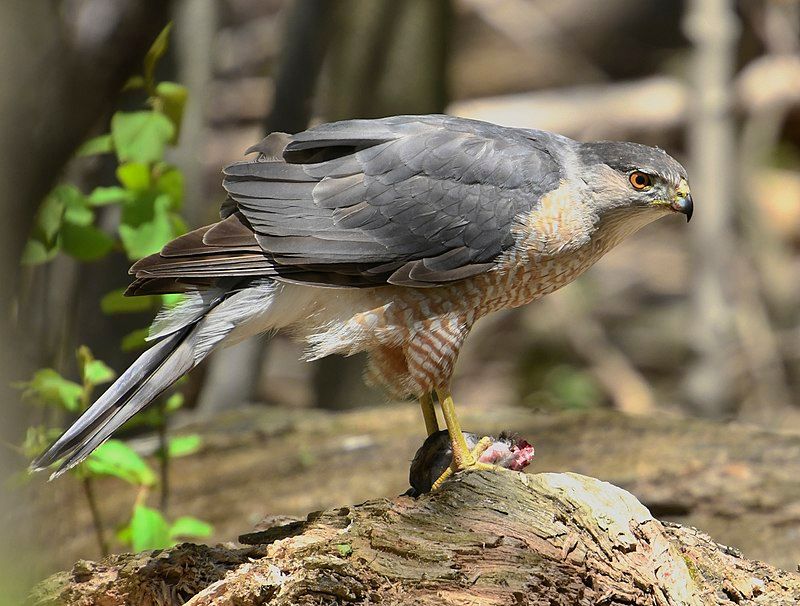
The Cooper’s Hawk is a medium-sized hawk, adept at navigating through dense foliage. They have a blue-gray back, reddish-barred chest, and a long, rounded tail with bands.
These birds are skilled hunters, feeding mainly on birds and small mammals. Cooper’s Hawks are found in wooded habitats and are increasingly seen in urban and suburban areas.
They are swift and agile in flight, often surprising their prey. Their call is a sharp, high-pitched cackle.
| Kingdom | Animalia |
| Phylum | Chordata |
| Clade | Dinosauria |
| Class | Aves |
| Order | Accipitriformes |
| Family | Accipitridae |
| Genus | Accipiter |
| Species | A. cooperii |
50. Eastern Towhee (Pipilo erythrophthalmus)
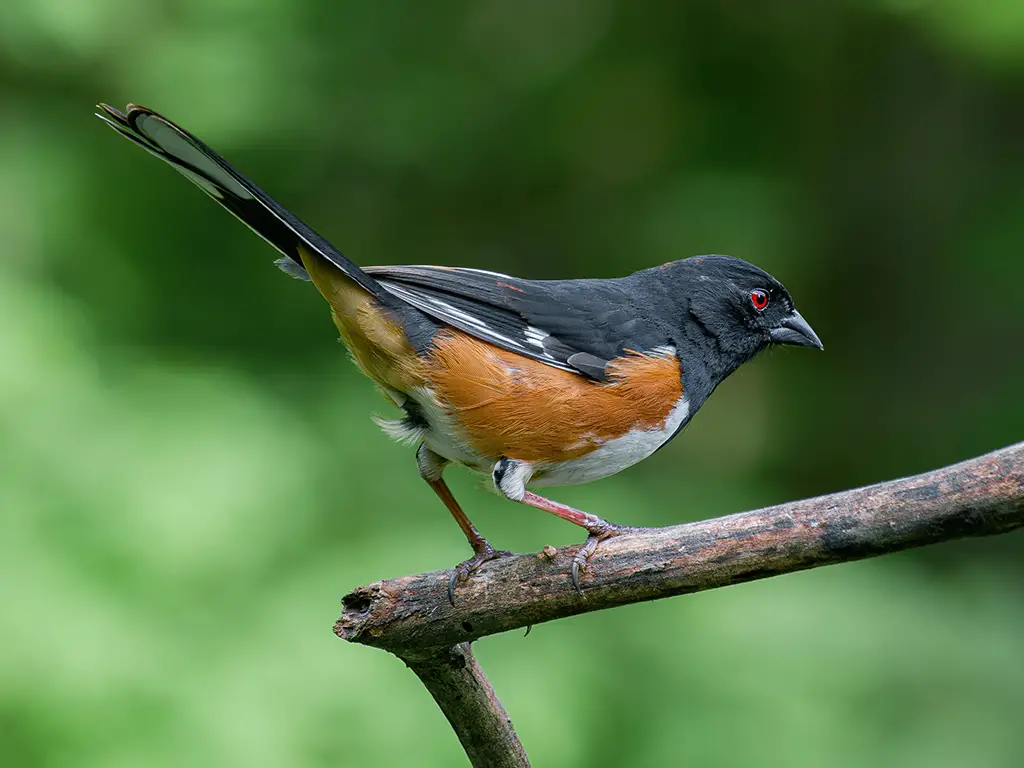
The Eastern Towhee is a large sparrow with striking plumage – males have a black head, back, and tail, with a white belly and rufous sides, while females are brown where males are black.
They are ground feeders, often seen scratching in the leaf litter for insects, seeds, and berries. Their song is a loud, clear “drink-your-tea!” They inhabit brushy areas, edges of woods, and overgrown fields.
Eastern Towhees are more often heard than seen, as they tend to stay hidden in thick underbrush.
| Kingdom | Animalia |
| Phylum | Chordata |
| Clade | Dinosauria |
| Class | Aves |
| Order | Passeriformes |
| Family | Passerellidae |
| Genus | Pipilo |
| Species | P. erythrophthalmus |
51. Common Grackle (Quiscalus quiscula)
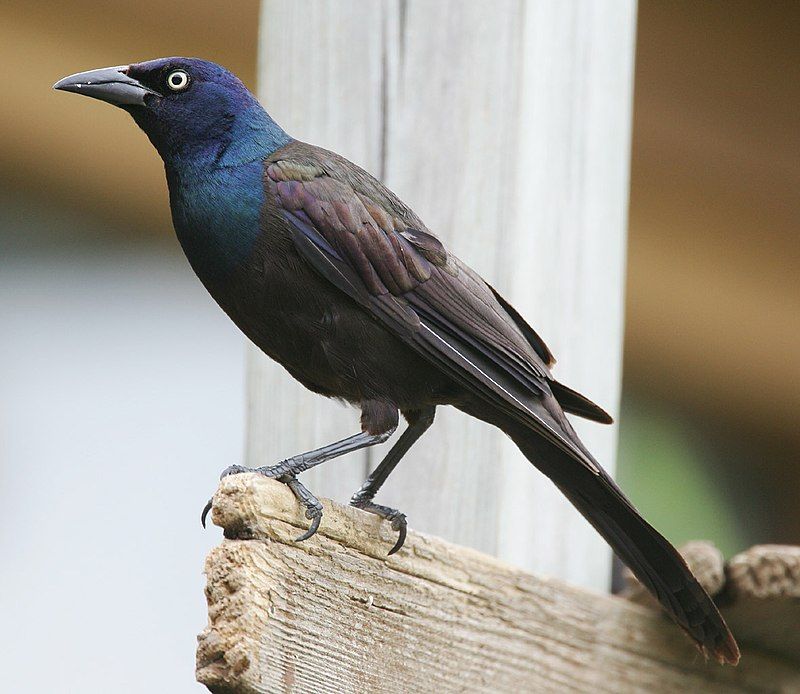
The Common Grackle is a large blackbird with a long tail and an iridescent blue-black plumage. They have a distinctive yellow eye.
Grackles are omnivorous, feeding on a wide range of foods including insects, grains, small animals, and garbage.
They are known for their loud, harsh calls. Common Grackles are adaptable and often found in large, noisy flocks in varied habitats, including farms, parks, and suburban areas.
They can be aggressive toward other birds at feeders and are considered a pest in some areas due to their large numbers.
| Kingdom | Animalia |
| Phylum | Chordata |
| Clade | Dinosauria |
| Class | Aves |
| Order | Passeriformes |
| Family | Icteridae |
| Genus | Quiscalus |
| Species | Q. quiscula |
Conclusion
Winter birds in Virginia bring life and vibrancy to the otherwise quiet and chill season. With their stunning colors, unique behaviors, and melodic songs, they enchant both experienced birdwatchers and curious onlookers.
From the majestic Northern Cardinal to the quick and agile Black-capped Chickadee, these winter visitors prove that even in the cold and harsh conditions, beauty and resilience can thrive.
Birdwatching in Virginia during the winter months offers a wonderful opportunity to connect with nature, appreciate the diversity of avian species, and gain a new perspective on the wonders of the natural world.
Whether it’s in your backyard or on a snowy hike through the woods, encountering winter birds in Virginia is a magical experience that brings joy and a sense of wonder to all who observe them.